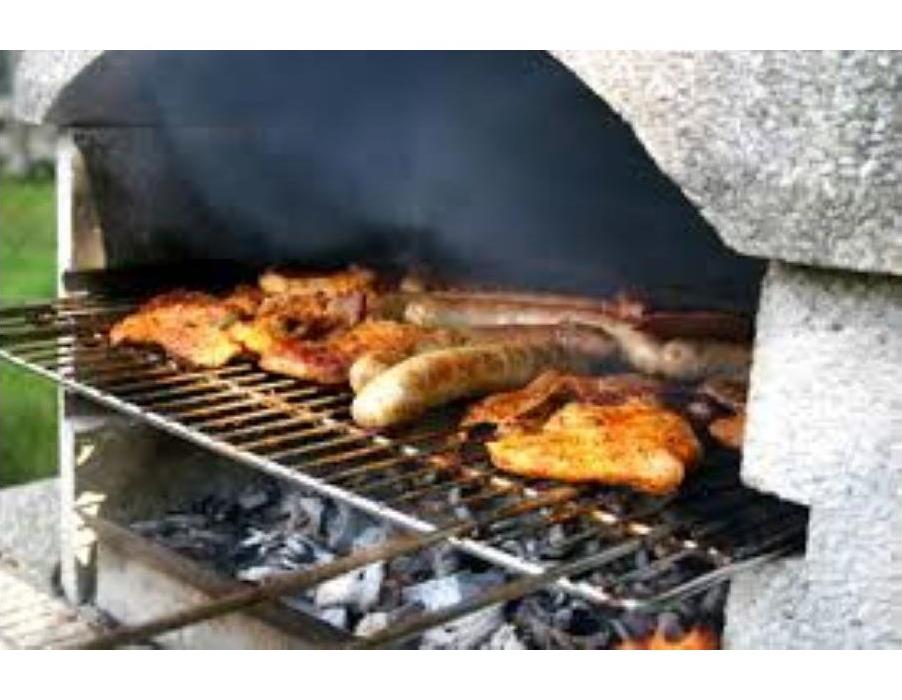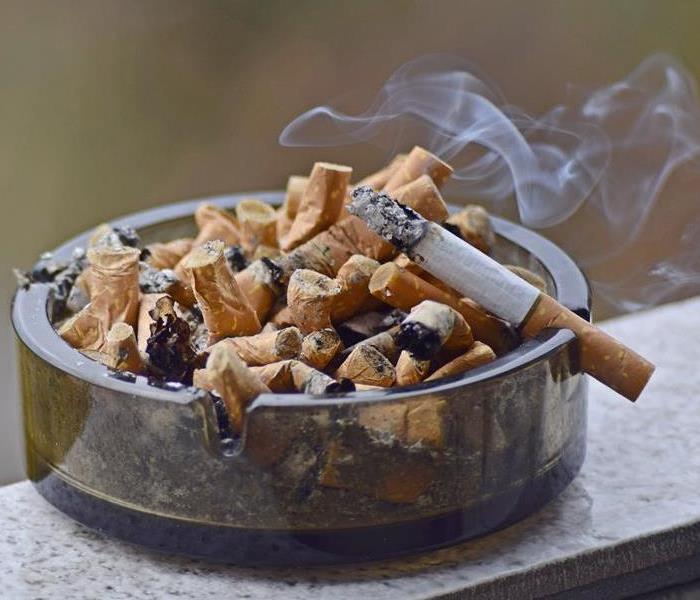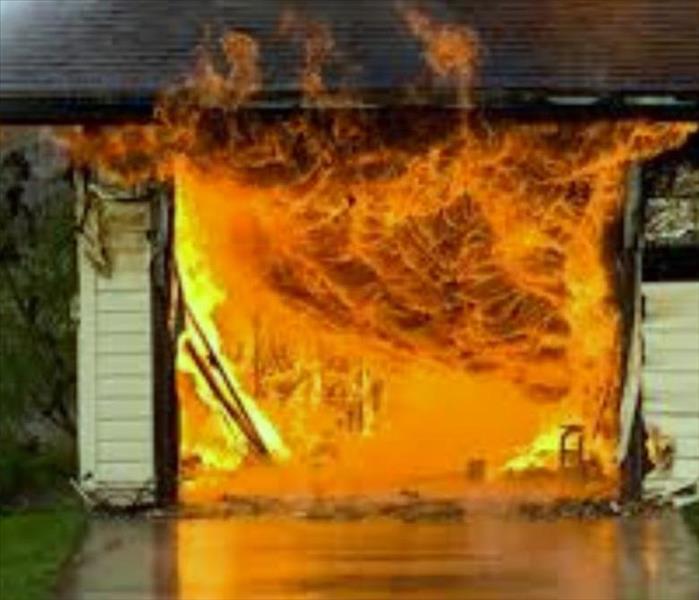Recent Fire Damage Posts
Fire Restoration and Flame-Proofing Your Home: A Comprehensive Guide
8/21/2024 (Permalink)
With the increasing threat of wildfires, especially in regions prone to dry conditions, it’s more important than ever to prepare your home against fire hazards. Fire restoration involves not only repairing damage after a fire but also taking proactive steps to make your property as flame-resistant as possible. Fortunately, the certified team at SERVPRO of Lafayette / Moraga / Orinda is available 24/7 for fire damage restoration, ensuring you have the support you need when it matters most.
1. Defensible Space
Creating a defensible space around your home is crucial. This involves clearing away flammable vegetation, debris, and any materials that could act as fuel for a fire. The goal is to create a buffer zone that slows down or stops the spread of fire before it reaches your home. In California, the law requires a 100-foot defensible space around homes in wildfire-prone areas.
2. Fire-Resistant Landscaping
Choose plants that are less likely to ignite and spread fire. Opt for succulents, hardwood trees, and other fire-resistant species. Keeping trees and shrubs well-watered and pruned is essential, and ensure that mulch and other ground cover are made from non-flammable materials to further protect your home.
3. Fire-Rated Roofing and Siding
The materials used in the construction of your home can significantly affect its fire resistance. Consider upgrading to a Class A fire-rated roof made from non-combustible materials like metal, slate, or tile. Similarly, siding made from fiber cement, stucco, or brick offers better protection than wood or vinyl, helping to safeguard your home against fire damage.
4. Ember-Proof Vents and Openings
Many homes catch fire due to embers entering through vents or other openings. Installing ember-resistant vent covers and sealing any gaps in your home’s exterior can prevent these tiny sparks from igniting your home. This small step can have a big impact on your fire safety.
5. Regular Maintenance
Keep your home fire-ready by regularly cleaning gutters, roofs, and decks of debris. Trim trees away from power lines and clear away any dead vegetation or dry leaves. This ongoing maintenance will help you stay ahead of potential fire risks.
6. Emergency Preparedness
Have an evacuation plan in place, and make sure your family knows what to do in case of a fire. Keep important documents, valuables, and emergency supplies in a fire-resistant safe or a location that can be easily accessed during an evacuation. Being prepared can make all the difference during a crisis.
By taking these steps, you can significantly reduce the risk of fire damage to your home and improve the safety of your family and property. If you do experience fire damage, remember that the certified team at SERVPRO of Lafayette / Moraga / Orinda is available 24/7 for fire damage restoration, ready to help you restore your home and peace of mind. Don't wait until it's too late—start implementing these fire safety measures today!
If you’re dealing with fire damage or smoke damage, don’t hesitate to contact us. We’re here 24/7 to help you restore your property. Call us today at (925) 962-2262.
Electric Fire in Garage
7/21/2023 (Permalink)
Electric Fire in Garage
An Electric Chair caused this Fire in Moraga
This picture shows all the residue this fire left behind; it is very important that we maintain all our electrical appliances in order so we can prevent these accidents.
Of course, we know that accidents can happen, our independently owned and operated franchise of SERVPRO is ready to respond to disaster 24/7, Our Goal is to leave your home “Like it never even happened”.
Preventing a Fire Loss
5/2/2022 (Permalink)
Smoke detectors are an essential investment that can protect homes against fire. With smoke alarms, homeowners get alerted when there is a fire in the home, enabling them to take quick measures, such as calling for urgent help from emergency responders to prevent fire outbreaks.
Homeowners need to install smoke alarms on every floor in their home and outside every bedroom. Interconnected alarms are the best option because they communicate with each other when there is a fire danger.
Fire Safety Plan
5/2/2022 (Permalink)
Creating a fire escape plan is the best way to avoid getting caught in a dangerous situation without knowing what to do.
Every homeowner should create a plan that includes fire safety tips and fire safety rules. This will help homes during an emergency. With a proper plan, homes will have a fire escape strategy and evacuate every family member in time to a safe place. Every house should have at least two or three escape routes, and all family members should be informed and reminded about the escape routes.
Preventing a Fire Loss
5/2/2022 (Permalink)
After installing smoke alarms, homeowners need to continue to ensure that the alarms are working properly. It is best to check them for any damage and repair them if the system has any issues.
Homeowners should also create a fire safety checklist and routinely check things like fire alarms to determine whether all fire protection equipment in the home is working effectively. This can prevent avoidable fire outbreaks and keep the home safe in the long run.
Practice Electrical Safety
5/2/2022 (Permalink)
Most fires in homes occur due to various electrical faults and problems. As such, it is best to ensure electric appliances stay in good condition daily to ensure fire safety in the home.
Homeowners should check for potential hazards and take immediate measures to prevent a fire outbreak. In case of a fire outbreak, homeowners should call their local fire department in order to get the fire under control.
Commercial Fire Loss
4/5/2022 (Permalink)
SERVPRO of Lafayette/Moraga/Orinda is a national leader in remediation and restoration ,with the ability to respond to any disaster, regardless of size. No job is too small or too big for SERVPRO. Our team of highly dedicated restoration technicians are willing to do the dirty work when other companies shy away. When dealing with a commercial lost , it is important to act fast , as unaddressed damages can cause serious harm to your building and business.
SERVPRO of Lafayette/Moraga/Orinda offers an array of services to remediate the damages incurred by your commercial loss, such as water mitigation , fire damage restoration, pack outs , and proprietary cleaning methods. When dealing with a large commercial fire loss , it is important to remain away from the property till cleared by the fire department and emergency personnel. Staying away will enable emergency services to effectively put out the damage. Water damage on a commercial level, presents an array of problems such as mold growth and damage to the structure integrity of your building. It is advised to remain out of the area , as the potential for conduction from electronic outlets and water combined pose a risk.
SERVPRO of Lafayette/Moraga/Orinda can pack out and store your contents off-site at a secure location till the remediation has concluded. SERVPRO of Lafayette/Moraga/Orinda knows how to accurately document each item loss.
Call us at (925)299-1323
Fire Restoration
11/22/2021 (Permalink)
It’s always devastating when a family experiences a house fire, it spreads very quickly to valuables and other items can’t always be saved. SERVPRO of Lafayette/Moraga/Orinda is experienced in fire mitigation and here to remediate your damages "Like it never even happened." Pack-outs are a vital component in the mitigation process as it allows for our team of highly trained technicians to restore your valuable belongs rather than replacing . While most mitigation work can happen on-site, SERVPRO of Lafayette/Moraga/Orinda has the ability to take your precious belongings offsite, where we focus on specialized attention in cleaning each item, to restore it to its original form. Once your items have entered our facility, we assess the damages and choose which remediation approach. Disaster is unique, so our trained remediation technicians use a multitude of approaches such as ozone chamber , ultrasonic cleaning tank and many other methods.
Don't Be Helpless
11/10/2021 (Permalink)
In California, fire has become an expectation every year. However, this doesn’t mean we need to be victims or be helpless in the face of these events. Everyone can take a few simple measures to minimize or eliminate these disasters. Being prepared is the best first step to take. Here are a few preparedness steps you can take to help you to not be helpless.
- Remove overgrown foliage and other combustible materials from around your house and property.
- Have emergency supplies packed and ready when the time comes. Make sure that your emergency supplies contain a gallon of water per resident, food, and all needed medicines.
- Have and maintain fire extinguishers in the home, especially in the kitchen, garage, vehicles, and detached structures.
- Keep copies of all important documents in a safe and easily accessible location in case you need to leave.
Remember in case of fire damage please call SERVPRO of Lafayette/Moraga/Orinda at (925)299-1323
Can Water Damage Happen to You?
11/10/2021 (Permalink)
Can water damage happen to you? The answer is yes. About 37% of all households in the US have experienced damage caused by water. Broken or burst pipes, leaking roofs, back pressure and storms are just a few ways water can damage your home. It is nearly impossible to safeguard against all forms of intrusion. However, you can take simple preventative measure to help you minimize these possibilities.
At least once per year you should perform simple inspection of your home. Make sure to check water lines for cracks or signs of stress, make sure gutters are clear of debris, check the roof for missing or lose shingles or other damages and check windows and doors seals to ensure they are not damaged or if significant gaps exist. Doing these periodic checks can help eliminate water damage events in the future. Remember, “Fortune favors the PREPARED!”
In case of water damage please call SERVPRO of Lafayette/Moraga/Orinda at (925)299-1323
Pet Fire Safety Tips That Could Paws-Sibly Save Lives
8/5/2021 (Permalink)
Pet Fire Safety Tips
We all adore our pets, and the last thing we want to think about is one of them being injured in a fire. Making pets a part of your family entails more than just providing them with a warm bed and plenty of tasty food. It also entails doing all possible to make your home fire-safe for your pet. Making sure your smoke detectors and fire extinguishers are in good working order is essential for protecting your family ad your pets. If you must escape in the event of a disaster, the most critical thing you can do to safeguard your pets is to evacuate them as well. Here are a few things to consider to help avoid fires and increase the odds of firefighters rescuing your pets in the event of a fire.
Put pets near entrances when away from home.
When you’re not at home, keep your pets near the front door. Keep leashes and collars on your pets in case firefighters need to rescue them. Keep pets in places or rooms near entrances where firefighters may easily find them, especially if visibility is poor due to smoke.
Secure small and young pets.
When you’re not at home, keep your pups contained, preferably in crates or behind baby gates in secure settings, away from potential fire-starting materials.
Use Monitored Smoke Detectors.
Install smoke detectors linked to emergency response services so that, even if your pets are home alone, help can be signaled and dispatched in the event of a fire.
Be aware of where your pets are most likely to hide.
Knowing where they’re more likely to hide or sleep can help you locate your pet quickly and safely in the event of an emergency. Ensure you know where they might hide inside the house, such as beneath a couch or in a specific closet.
Keep tags and microchips up to date.
Collars, for example, are very beneficial in extreme situations. If all you can do to keep safe in an emergency is open the door and let your pet run out to safety, a tag on your collar is better than nothing. It’s also good to have your pet microchipped and make sure the chip and tag are updated with current contact information.
Prepare an emergency kit.
If you need to leave right away, an emergency kit can guarantee you have everything you need. Food, amenities such as plastic bags or kitty litter, medical paperwork, and comfort items such as blankets or toys are all included in a basic pet safety kit. You’ll need a leash or a pet carrier as well. Make sure everyone in your household knows where the kit is by placing it near the main exit.
Put up a window decal with a pet alert.
If you are not at home when a fire starts, emergency personnel may not be aware that pets in the building need to be saved. A pet alert window decal, which is a card inside a clear sticky window that you can place on your door, can address this problem. In addition, you can write down how many pets you have on the card so that emergency services are aware of them in the event of a fire at your home.
Make a pet fire safety evacuation plan.
All pet parents should have an emergency plan in place and practice escape routes with their dogs. Include all family members in this plan and understand what steps to take and where to go. Preparing for pet safety ahead of time can significantly reduce your risk.
In an emergency, the most important thing is that everyone in your family, including your pets, is safe. So, make every effort and plan ahead of time to be confident that you have all your bases covered. SERVPRO of Lafayette/Moraga/Orinda specializes in fire damage restoration and is available 24 hours a day, 7 days a week. Their professionals are qualified and experienced in restoring your home or property to its former glory. Contact the experts at SERVPRO after a disaster even, and we’ll be here to help.
What You Should Always Throw Away After a Fire in Your Pleasant Hill Home
8/4/2021 (Permalink)
One of the most challenging aspects of a fire recovery is determining what can be saved and discarded. It’s heartbreaking to throw away sentimentally valuable goods, and it seems wasteful to toss food that has been exposed to smoke. The cost of restocking your pantry and refrigerator, on the other hand, is well worth avoiding the potential health effects of eating infected food! So follow our advice and throw away these four items after a fire, no questions asked, for your safety.
- Burned Clothing
It’s not always a good idea to clean and sanitize fabrics such as clothing and bedding after a fire. Chemicals found in smoke and soot can irritate the skin when they come into touch with it, and those chemicals can be inhaled if the items are worn or used.
- Cosmetics and Toiletries
Chemicals and minerals in your cosmetics and toiletries could be harmed by the fire’s intense heat, pollutants in the extinguishing water, and chemicals used by firemen to put out the fire. So even though the cosmetics may appear in good condition, it is safer to discard them.
- Medicine
Tremendous heat, smoke, soot, water, and chemicals used by firemen to extinguish the fire can all impact the potency of your medications.
- Food Items; Both Perishable and Non-Perishable
Food items such as cans and jars are frequently found in every home. Even if the food appears to be unharmed by the fire, the extreme heat within the cans or jars can activate bacteria. In addition, the water and chemicals used to put out the fire can contaminate the food in the home.
Who To Call for Fire Cleanup?
If your fire damage is sizable, you should call a fire restoration company like SERVPRO of Lafayette/Moraga/Orinda. We have the equipment and skills necessary to clear up any size fire. Cleaning smoke and soot stains, reducing flame and heat damage and returning your property to the way it was before the fire are all part of the process.
Call SERVPRO of Lafayette/Moraga/Orinda today if you need help deciding what to toss away and what can be saved after a house fire. After a fire, our restoration experts will clean up and repair your home. For a free estimate on fire damage restoration services, call (925) 299-1323.
Dryer Fire Prevention Tips: Do's and Don'ts for Your Lafayette Home
5/5/2021 (Permalink)
Avoiding a Dryer Fire in Your Lafayette Home
Dryer fires are one of the leading causes of fires reported each year. Dryer fires are much more common than many think. It’s essential to understand what causes dryer fires and how to prevent them from happening in your own home with so much at stake. Safeguard your home and follow the dryer dos and don’ts from the experts at SERVPRO of Lafayette/Moraga/Orinda.
DO: Clean the Lint Filter
Remember to clean the lint trap every time you unload the dryer. Before loading the next set of clothing, ensure the lint trap is completely cleared out to lower your fire risk. A clean lint filter enables the dryer to run more efficiently, making dryer your clothes faster while also hindering your machine from overheating.
DON’T: Dry Clothes without the Lint Filter
Without a lint trap in the dryer, it only allows for accidents to happen. The filter protects the dryer’s mechanics from collecting lint. If this defensive shield is absent, a buildup of lint in the ducts can quickly lead to a dryer vent fire. To lower your risk for potential fires, always use your dryer with the lint trap in its proper place.
DO: Inspect the Ducts Regularly
Blocked ducts commonly cause dryer fires. Ensure your dryer is running correctly, check your ducts monthly to make sure there are no blockages. If you notice any blockages, clean them out before turning on your dryer again. To clean your ducts, disconnect them, clear them out, and reconnect them. If you witness any damage to the venting system, call a professional to repair the issue.
DON’T: Overload the dryer
Loading too many wet clothes or bedding into a dryer can accumulate an excessive amount of lint. Because lint buildup hinders a dryer’s ability to ventilate, that can cause the machine to overheat and create a fire.
DO: Replace Outdated Ducts
Older ducts made of plastic or foil are prone to sagging, interfering with the machine’s proper functioning. Accordion-style ducts can trap lint in hard-to-reach spaces, increasing your risk of fire. To prevent this, replace your older ducts with newer models designed with industrial-strength metal.
DON’T: Leave the Dryer Running Unattended
Be sure to never go to sleep or leave the house while your dryer is running. If a fire breaks out, your ability to extinguish it or call emergency services right away can significantly impact the damage caused and can lead to the total loss of your home.
Despite our best efforts as homeowners, accidents still happen. If your home has been damaged by fire and smoke, call SERVPRO of Lafayette/Moraga/Orinda. Our residential fire and smoke damage restoration services can help get your life back to normal as quickly as possible. With the proper training, innovative equipment, and helpful guidance, our expert technicians will be with you every step of the way to get you back on your feet.
Home Fire Damage Prevention Tips in Your Moraga Home
5/5/2021 (Permalink)
Preventing Fire Damage in Your Moraga Home
Most people know the basics of fire safety at home, such as not leaving burning candles unattended and keeping a fire extinguisher on hand. Here are more tips you can use to prevent fires at home.
Home Fire Prevention
Check your smoke and carbon monoxide detectors.
Make sure to test your smoke and CO detectors every month and replace the batteries at least once a year. Additionally, install a smoke detector on each level of your home to cover all your bases.
Inspect your gas appliances
Maintain your appliance by checking your water heater, gas stove, furnace, and dryer once a year. This ensures all the appliances’ connections to gas lines are working as they should and are in the proper condition. In addition, do not under any circumstances put combustible materials near gas appliances.
Get an Annual Inspection
Have a professional carry out a preventative maintenance assessment of your home’s heating and cooling systems yearly. This gives you the peace of mind that you’re heating and cooling systems are installed correctly, thereby helping you avoid a disaster event.
Be Cautious While Cooking
When you are cooking, do not leave any stoves unattended. Make sure to turn cookware handles toward the back of the stove, so that young children cannot accidentally knock over a boiling pot. If a grease spill occurs, be sure to wipe away any grease residue as soon as it reaches a cool temperature because it can easily catch fire.
Remove dryer lint buildup.
Dryer lint that accumulates in your dryer’s removable filter is highly flammable. If the lint is not removed after each load of laundry, it can cause a fire. Also, look out for and remove lint buildup around the dryer’s exhaust hose at least once a year.
Repair damaged power cords
If the plastic casing around your power cords is damaged, it could lead to an electrical fire that can occur if the cord is in use. Remove any power cords or appliance cords that are damaged before continued use.
Do not overload electrical outlets
Ensure that you do not have too many appliances in one outlet because it can overload a circuit and potentially lead to a fire. You can prevent this by limiting the number of devices that are plugged into a power outlet.
About SERVPRO of Lafayette/Moraga/Orinda
SERVPRO of Lafayette/Moraga/Orinda specializes in the cleanup and restoration of residential and commercial property after a fire, smoke, or water damage event. Our staff is highly trained in property damage restoration. From initial and ongoing training at SERVPRO’s corporate facility to regular IICRC-Industry Certification, rest assured our staff is equipped with the knowledge to restore your property.
Wildfire Prevention and Safety Tips
5/4/2021 (Permalink)
Wildfires can occur at anytime and anywhere throughout the year. Late summer and early fall is typically the peak time for wildfires in California. People that live or work in an area prone to wildfires are at greater risk. Wildfires sometimes start naturally by heat ignited from sun light or lightning strikes. However, majority of the wildfires in the U.S. are caused by humans. Some human-caused fires result from campfires left unattended, negligently discarded cigarettes or intentional acts of arson. A wildfire can move as fast as 6.5 miles per hour in forest and 14 miles an hour in grassland, consuming trees, homes, natural resources, humans and everything in its path.
By working together, we can make our residents and neighborhood safer from wildfires by taking safety precautions. Here are some wildfire safety tips to help prevent wildfire from occurring.
Wildfire Safety Tips
- Clear leaves and other debris from gutters, eaves, porches and decks. Remove dead vegetation from under your deck and within 10 feet of the house. This prevents embers from igniting your home.
- Remove anything stored underneath decks or porches. Screen or box-in areas below patios and decks with wire mesh to prevent debris from accumulating.
- Ensure flammable materials (firewood stacks, propane tanks, dry vegetation) are more than 30 feet from your home or business's foundation and outbuildings.
- Wildfire can spread to tree tops. If you have trees on your property, prune so the lowest branches are 6 to 10 feet from the ground.
- Keep your lawn hydrated and maintained. If it is brown, cut it down to reduce fire intensity. Dry grass and shrubs are fuel for wildfire.
- Inspect shingles or roof tiles. Replace or repair shingles that are loose or missing to prevent ember penetration.
- Cover exterior attic vents with metal wire mesh no larger than 1/8 inch to prevent sparks from entering the home.
- Enclose eaves and screen soffit vents using 1/8 mesh metal screening to prevent ember entry.
SERVPRO of Lafayette/Moraga/Orinda specializes in fire and water damage restoration. We have the specific damage restoration training, personnel, and equipment and can quickly restore your home to pre-fire condition. Call us today 925-299-1323.
Fire Safety Tips When Cooking
5/4/2021 (Permalink)
As we look forward to the upcoming holiday season of Memorial Day, Independence Day and Labor day (to name a few) many of us will invite our family and friends to celebrate these major holidays. These can be exciting especially preparing some delicious dishes for the party. Whether you’re cooking indoor or outdoor, there is always a potential for fire hazard in the kitchen or in the backyard. Did you know that U.S. fire departments responded to an average of 166,100 home structure fires that involved cooking equipment per year? The leading cause of fires in the kitchen is unattended cooking. So before you turn on your stove, here are some fire safety tips prevention.
Here's What You Need to Know:
• Be on alert! If you are sleepy or have consumed alcohol don’t use the stove or stove top.
• Stay in the kitchen while you are frying, grilling, boiling or broiling food.
• If you are simmering, baking or roasting food, check it regularly, remain in the kitchen while food is cooking, and use a timer to remind you that you are cooking.
• Keep anything that can catch fire—oven mitts, wooden utensils, food packaging, towels or curtains—away from the stovetop.
What to Do During a Fire:
• Just get out! When you leave, close the door behind you to help contain the fire.
• Call 9-1-1 or the local emergency number after you leave.
• For an oven fire turn off the heat and keep the door closed.
• If you try to fight the fire, be sure others are getting out and you have a clear way out.
• Keep a lid nearby when you’re cooking to smother small grease fires. Smother the fire by sliding the lid over the pan and turn off the stovetop. Leave the pan covered until it is completely cooled.
If you have the unfortunate experience of fire or smoke damage in your home or business call SERVPRO of Lafayette/Moraga/Orinda!
We are available 24 hours a day and are always Here to Help! Have Questions? Call Us Today – (925) 299-1323
Smoke Damage Clean up
11/23/2020 (Permalink)
Smoke and soot is very invasive and can penetrate various cavities within your home, causing hidden damage and odor. Our smoke damage expertise and experience allows us to inspect and accurately assess the extent of the damage to develop a comprehensive plan of action.
Smoke and soot facts:
- Hot smoke migrates to cooler areas and upper levels of a structure.
- Smoke flows around plumbing systems, seeping through the holes used by pipes to go from floor to floor.
- The type of smoke may greatly affect the restoration process.
Different Types of Smoke
There are two different types of smoke–wet and dry. As a result, there are different types of soot residue after a fire. Before restoration begins, SERVPRO of Lafayette / Moraga / Orinda will test the soot to determine which type of smoke damage occurred. The cleaning procedures will then be based on the information identified during pretesting. Here is some additional information:
Wet Smoke – Plastic and Rubber
- Low heat, smoldering, pungent odor, sticky, smeary. Smoke webs are more difficult to clean.
Dry Smoke – Paper and Wood
- Fast burning, high temperatures, heat rises therefore smoke rises.
Protein Fire Residue – Produced by evaporation of material rather than from a fire
- Virtually invisible, discolors paints and varnishes, extreme pungent odor.
Our Fire Damage Restoration Services
Since each smoke and fire damage situation is a little different, each one requires a unique solution tailored for the specific conditions. We have the equipment, expertise, and experience to restore your fire and smoke damage. We will also treat your family with empathy and respect and your property with care.
Have Questions about Fire, Smoke, or Soot Damage?
Call Us Today – (925) 299-1323
How To Plan After a Fire
11/13/2020 (Permalink)
As we all know, a house fire is a horrific experience full of devastation and destruction. Fires are unpredictable and it is important to execute a planned fire safety protocol where everyone knows where to go and how to get there safely yet hastily. After a fire occurs, there are important steps that one must take to relieve themselves of further turmoil. According to Ready.gov, there is a checklist that acts as a guide for what to do after a fire.
The first thing you want to do is find a safe place or shelter nearby. You can contact someone you know or the Red Cross for aide in this endeavor.
The second thing you want to do is contact your insurance company. The details regarding you’re your policy covers can only be made clear through speaking with your agent or representative. Usually they will recommend some fire damage restoration companies. If you are not insured, try contacting private organizations for aid and assistance.
The third thing you want to do is contact a fire department to see if your home is safe to return to. Also check and see with them if it is safe to use your utilities.
Make sure that you save every expense paid that is connected to the fire loss. This can come in handy when presented to your insurance company and for verifying losses claimed on income tax.
A fire is a difficult experience. However, having a plan for before and after a fire can make the process a little bit easier. Here at SERVPRO of Lafayette/Moraga/Orinda, making your home look “Like it never even happened,” is more than just a tagline. It’s how we do business.
Call us at (925)299-1323
Safety Tips in Case of a Fire at Home
8/5/2020 (Permalink)
Important and useful safety tips in case of a fire at home
In case of a fire at your home, your priority is to get yourself and your family members out as quickly as possible. There is no time to gather valuables. Fire can spread out within seconds and in just a few minutes, it can become life-threatening.
Don't attempt to extinguish any fire if there is a threat to your safety. If you're unable to exit your home safely because of smoke or fire, remain in your room until it is safe to do so. Keep door closed and await assistance from the fire department.
After the fire trucks leave, your home likely suffers from fire, smoke damage and extensive water damage from firefighting efforts. At SERVPRO of Lafayette/Moraga/Orinda, we have the specific damage restoration training, personnel, and equipment and can quickly restore your home to pre-fire condition.
Have Questions about Fire, Smoke, or Soot Damage?
Give us a call at (925)299-1323
Grilling Safety Tips
8/5/2020 (Permalink)
When the weather gets warmer, there’s nothing better than the smell of food on the grill. Grilling and cookouts are the most popular activities outdoor. It’s a great way to relax and have fun with family and friends. Weather the barbecuing takes place at the beach, picnic area, camping site or just out in the backyard, grilling can poses risk of fire if not handled properly. According to a (NFPA) National Fire Protection Association report, nearly 9,000 homes fires are caused by grilling in the US and close to half of all injuries involving grills are due to thermal burns.
Causes of Grill Fires:
The leading causes of grill fires were a failure to clean, having the grill too close to something that could catch fire and leaving the grill unattended.
A leak or break was the leading cause for outside or unclassified grill fires. Leaks or break were primarily a problem with gas grills.
General Grilling Tips:
- Propane and charcoal BBQ grills should only be used outdoors.
- The grill should be placed well away from the home, deck railings and out from under eaves and overhanging branches.
- Keep children and pets away from the grill area.
- Keep your grill clean by removing grease or fat buildup from the grills and in trays below the grill.
- Never leave your grill unattended.
If you encounter fire damage during this cookout season, give SERVPRO of Lafayette/Moraga/Orinda a call. We're dedicated to being faster to any size disaster, has the training, equipment and expertise to handle your restoration and cleaning needs. We’re close by and ready to respond immediately when you need us. We make disaster "Like it never even happened." Give us a call today at (925) 299-1323
Fire Safety - Essential Tips to Teach Childeren in Avoiding Fires
5/5/2020 (Permalink)
It is the primary responsibility of child care providers like teachers and parents to teach children about fire prevention and safety. It is an all year round concern especially that fires often happen inside the home. Teaching basic fire protection techniques in children will definitely increase their chances in surviving this tragedy. Here are 7 fundamental tips kids can learn about safety in fires.
1. Have an escape route planned.
In planning for an escape route for your family, it is important to have two methods to escape in each part of the house. This is done in the likelihood that your other exit is blocked or bursting in flames. Remind the children to never to leave things that can obstruct passageway to an exit. Fire safety techniques also include teaching children how to cover their face and use a towel in grabbing items to prevent burning themselves.
2. Instruct children how to dial 911 or the fire emergency number.
Knowing the local number for the fire department is significant. Emphasize this by letting them practice using an unplugged phone.
3. Teach children about escape ladders and finding their way out without lights on.
If your house has a second floor, escape ladders should be placed near the windows. Let your children practice using this fire safety exit. If there are small children, then let them practice from the first floor window so they will have a clear idea on what to expect in case a fire does break out. It is anticipated that a power outage can occur in a fire breakout. Teach your children how to find their way into the dark by blindfolding him and letting him feel his way into a room.
4. Provide them with basic information on smoke detectors and fire alarms.
Teach children about fire prevention equipment like smoke detectors and fire alarms. They should be able to associate the sound of an alarm with the need of evacuating themselves out of the house. Regularly check these devices and change batteries to ensure that it is operating properly.
5. Teach them how to stop, drop and roll if their clothes catch fire.
There is a possibility that a child may catch fire with his clothes. Make them understand the stop, drop, and roll technique to decrease risk of burn injuries.
6. Practice fire drill exercise with your kids monthly.
Fire drills with your whole family every month is one way of ensuring they are ready and equipped with the basic fire safety skills.
7. Clearly instruct your children to never go back to the burning house no matter what.
Tragedies often happen when survivors of a fire go back to the burning house to save someone else. Instill in your children to never return inside the house under any circumstances even if a member of the family or a pet is still missing. Report this to the professional firefighters to avoid further injuries or deaths.
It is always a good idea for parents to talk to their children on what they can do to escape a fire emergency. Different families may have different strategies but what is most important is that they know the fundamentals techniques in surviving a fire. Remember that being prepared will definitely save you and your children's lives.
Smoke and Soot Clean Up
5/5/2020 (Permalink)
Smoke and soot is very invasive and can penetrate various cavities within your home, causing hidden damage and odor. Our smoke damage expertise and experience allows us to inspect and accurately assess the extent of the damage to develop a comprehensive plan of action.
Smoke and soot facts:
- Hot smoke migrates to cooler areas and upper levels of a structure.
- Smoke flows around plumbing systems, seeping through the holes used by pipes to go from floor to floor.
- The type of smoke may greatly affect the restoration process.
Different Types of Smoke
There are two different types of smoke–wet and dry. As a result, there are different types of soot residue after a fire. Before restoration begins, SERVPRO of Lafayette / Moraga / Orinda will test the soot to determine which type of smoke damage occurred. The cleaning procedures will then be based on the information identified during pretesting. Here is some additional information:
Wet Smoke – Plastic and Rubber
- Low heat, smoldering, pungent odor, sticky, smeary. Smoke webs are more difficult to clean.
Dry Smoke – Paper and Wood
- Fast burning, high temperatures, heat rises therefore smoke rises.
Protein Fire Residue – Produced by evaporation of material rather than from a fire
- Virtually invisible, discolors paints and varnishes, extreme pungent odor.
Our Fire Damage Restoration Services
Since each smoke and fire damage situation is a little different, each one requires a unique solution tailored for the specific conditions. We have the equipment, expertise, and experience to restore your fire and smoke damage. We will also treat your family with empathy and respect and your property with care.
Have Questions about Fire, Smoke, or Soot Damage?
Call Us Today – (925) 299-1323
Ten Things I Needed During a Power Outage
11/20/2019 (Permalink)
 Top Ten!
Top Ten!
What I Needed During a Power Outage
October was full of unpredictable circumstances. The Kincade fire grew at an exponential rate and endangered our neighborhoods. PG&E had to take drastic precautionary measures by shutting off the power lines to around a million residents of both Sonoma, Napa, and Marin county. Fortunately, we had government support through a declaration of National Emergency which led to the dispatching of firefighters from neighboring cities, counties, and states. These brave people contained the fire and prevented major catastrophe.
The outage was an unfortunate circumstance and there were specific items that I wish I had in my possession to make the experience easier. The next time an outage occurs I want to be prepared and share with you the top ten essential items I needed during a power outage.
Top Ten List:
- First Aid Kit: Safety first!
- Powered Portable Charger(s): Cell phones or laptops are essential for daily living. Having a communication device during an emergency can be a lifesaver. Also, passing the time online when there is no power can make the process easier.
- Batteries: AA, AAA, or a backup battery are useful to power items that require them. Such as a flashlight or have in case you possess items that require batteries. Such as a flashlight, clocks, or radios.
- Flashlight: A flashlight is important for visibility at night. During a power outage, it can be difficult to move around. While I recommend having a LED flashlight, any normal light is useful to have.
- Gas: During the outage, many people had informed me that they were low on gas and therefore confined to their area until the power came back on or until someone can help them get to a gas station with power to be able to transfer gas back to their vehicles. Having a car filled with gas can also be essential for rapidly evacuating during an emergency.
- Cooler: The first thing I thought about during the outage was whether my food was going to spoil since our refrigerator was no longer running. Having a cooler could have erased this worry by transferring the food that would’ve spoiled without refrigeration. Of course, having a cooler alone won’t work in the preservation of your food.
- Manual Can opener: Can openers can be a huge aid when you need to open your non-perishable foods.
- Ice: This is the trickiest item on the list to have since a fire and outage are unpredictable. Ice does not have a long-life span as it melts easily and without refrigeration or a permanent cold environment, ice is a valuable resource that one needs to get an upper-hand when buying since it is the first thing to go at the grocery stores.
- Canned Food or Non-perishables: Being that food is a necessity for survival. Having food that does not perish without electricity can determine life or death. Well at least, that you don’t spend the days starving at least. Food includes: bars, nuts, candies, peanut butter, chips, beef jerky and much more.
- Bottled Water: The most important resource to have access to during a crisis. Preferably not stored in plastic but only if needed. Just make sure you don’t leave the bottles unattended in the car with sunlight directly hitting them.
Disclaimer:
This list is intended for short term emergencies and everyone has different needs therefore different priorities. That was my list of ten things I needed during the power outage. Hopefully, it helps.
Brought to you by SERVPRO® of Lafayette/Moraga/Orinda
How to Plan After a Fire
11/15/2019 (Permalink)
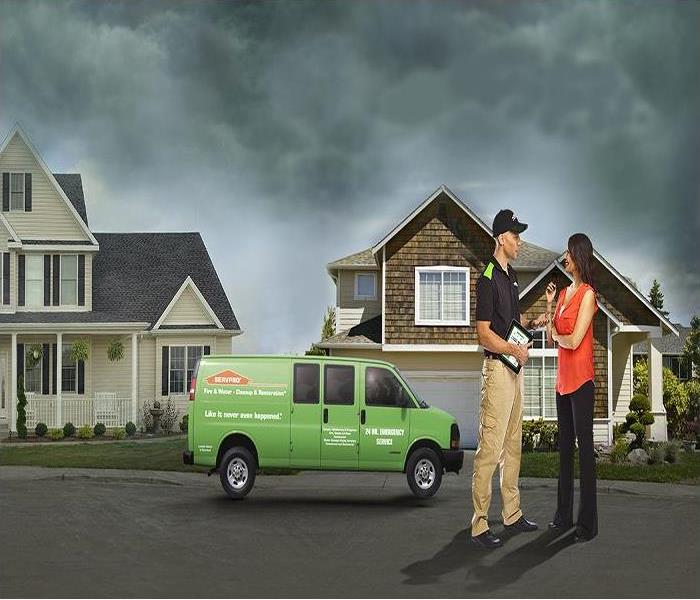 FASTER TO ANY SIZE DISASTER
FASTER TO ANY SIZE DISASTER
As we all know, a house fire is a horrific experience full of devastation and destruction. Fires are unpredictable and it is important to execute a planned fire safety protocol where everyone knows where to go and how to get there safely yet hastily. After a fire occurs, there are important steps that one must take to relieve themselves of further turmoil. According to Ready.gov, there is a checklist that acts as a guide for what to do after a fire.
The first thing you want to do is find a safe place or shelter nearby. You can contact someone you know or the Red Cross for aide in this endeavor.
The second thing you want to do is contact your insurance company. The details regarding you’re your policy covers can only be made clear through speaking with your agent or representative. Usually they will recommend some fire damage restoration companies. If you are not insured, try contacting private organizations for aid and assistance.
The third thing you want to do is contact a fire department to see if your home is safe to return to. Also check and see with them if it is safe to use your utilities.
Make sure that you save every expense paid that is connected to the fire loss. This can come in handy when presented to your insurance company and for verifying losses claimed on income tax.
A fire is a difficult experience. However, having a plan for before and after a fire can make the process a little bit easier. Here at SERVPRO of Lafayette/Moraga/Orinda, making your home look “Like it never even happened” is more than just a tagline. It’s how we do business.
Campfire Safety Tips You Should Always Keep in Mind
8/7/2019 (Permalink)
When you are out camping, you have to light a campfire. Campfires are an important aspect of a camping trip where you roast marshmallows, share campfire stories, and create countless memories that last a lifetime. However, when camping and cooking, there is one thing that is of utmost importance: campfire safety.
Even a small campfire can potentially become an unmanageable and dangerous wildfire, causing some serious damage if not handled with care. Therefore, to make sure your camping adventure is disaster-free and full of great memories, it is important for you to follow these campfire safety tips on your next camping trip.
Scout for Pits Watchfully
Thinking about campfire safety even before lighting the fire is the first step to ensure a disaster-free trip. Therefore, when searching for a fire pit, you need to make sure there are no bushes nearby and it's not located under any low branches.
Keep Water Nearby
A new piece of wood or even a gust of wind may result in your fire growing larger than expected. However, by having water or dirt (along with a shovel) on hand, you can put out or reduce the flames quite effectively.
Safety Proof Your Fire Pit
Sure, most campgrounds have a fire pit already dug, but there are a few extra measures you should take:
- Keep all flammable items, including pressurized containers and aerosol cans away from the campfire.
- Keep the fire pit clear from all kinds of debris, including grass, garbage, and leaves.
- Circle the pit with big rocks or a metal ring to keep the fire under control and within the borders.
Moreover, you can also ask your campground ranger if you have any questions or concerns. Campfire safety is their top priority too (obviously), and they can check to ensure whether or not the pit is ready for use.
Watch the Fire
You must keep an eye on the fire at all times, especially if there are children and pets walking or sitting nearby. Ensuring the fire is built properly from the beginning is important as it will allow you to create a fire at a rate that is controllable and safe. Here are some things you should keep in mind:
- Do not use flammable liquids, as they can quickly become uncontrollable.
- Using small sticks, start a fire, and then place the wood around it. Add dry, larger pieces as it continues to grow.
Put Out the Fire before Bedtime
This one is a given. You need to extinguish the fire when it's time for bed, and this can be done by throwing dirt or slowly trickling water onto the fire. To ensure another fire does not start, stir the embers around a little.
Keep the campfire safety tips in mind, and rest assured your camping trip will be fun and safe.
Article Source: https://EzineArticles.com/expert/Trev_Fenner/2127772
Important Ways to Reduce the Risk of a Smoking-Related Fire
8/7/2019 (Permalink)
Who doesn't know smoking cigarettes or other smoking material is bad for you? Even though the focus of lung and heart health is correct, some fail to realize that smoking is a genuine fire hazard for home owners, renters, business operators and more as well. Smoking is the scrooge responsible for the majority of house and other structure fires. It is also the number one trigger of wild and forest fires. Fires caused by smokers result in devastating damages and losses - including tragic and irreplaceable loss of life.
Home insurance professionals remind policyholders that although there is coverage for fire accidents resulting from smoking, losses will generally not be completely compensated for after a related claim has been filed.
The best way to reduce the risks of a fire associated with smoking is to take the following easy course of action brought to you by the insurance industry.
8 Ways Smokers can Reduce the Risk of Property Fire
- Never-ever smoke while resting in bed. If you fall asleep. Studies indicate that many people fall asleep with the cigarette in hand, leading to fire spreading from the sheets, mattress and bed onto the entire home.
- Don't light up after swallowing medicine with warnings about drowsiness occurring. You can find yourself in the same situation as the smoker in bed that drifts off and starts a fire.
- Always extinguish your cigarette before discarding it. Live embers can easily spark a fire.
- Do not clear out ashtrays that have recently been used into a garbage receptacle where things can easily spark into a full-fledged fire. Used-cigarettes, the hot ash emanating from them and matches used to light up can be the dangerous catalyst for fire once they come in contact with combustible matter.
- Be aware of your surroundings and when smoking do not go near incendiary places like gas stations - or items that can spark easily, such as gas, paints, aerosol cans, paper reading material and easy-to-explode medical oxygen tanks.
- Never place an ashtray next to flammable things or upon a window where the wind can blow its contents about, setting the stage for a fire.
- When outside, always dispose of your cigarettes and smoking material properly into a wide ashtray, receptacle containing water or sand.
- Be extremely careful to put cigarettes and related smoking material out of the way so that children cannot get their hands on them.
Article Source: https://EzineArticles.com/expert/M_Wyzanski/2158115
Fire Safety - 7 Essential Tips to Teach Children in Avoiding Fires & Remaining Safe in an Emergency
5/6/2019 (Permalink)
It is the primary responsibility of child care providers like teachers and parents to teach children about fire prevention and safety. It is an all year round concern especially that fires often happen inside the home. Teaching basic fire protection techniques in children will definitely increase their chances in surviving this tragedy. Here are 7 fundamental tips kids can learn about safety in fires.
1. Have an escape route planned.
In planning for an escape route for your family, it is important to have two methods to escape in each part of the house. This is done in the likelihood that your other exit is blocked or bursting in flames. Remind the children to never to leave things that can obstruct passageway to an exit. Fire safety techniques also include teaching children how to cover their face and use a towel in grabbing items to prevent burning themselves.
2. Instruct children how to dial 911 or the fire emergency number.
Knowing the local number for the fire department is significant. Emphasize this by letting them practice using an unplugged phone.
3. Teach children about escape ladders and finding their way out without lights on.
If your house has a second floor, escape ladders should be placed near the windows. Let your children practice using this fire safety exit. If there are small children, then let them practice from the first floor window so they will have a clear idea on what to expect in case a fire does break out. It is anticipated that a power outage can occur in a fire breakout. Teach your children how to find their way into the dark by blindfolding him and letting him feel his way into a room.
4. Provide them with basic information on smoke detectors and fire alarms.
Teach children about fire prevention equipment like smoke detectors and fire alarms. They should be able to associate the sound of an alarm with the need of evacuating themselves out of the house. Regularly check these devices and change batteries to ensure that it is operating properly.
5. Teach them how to stop, drop and roll if their clothes catch fire.
There is a possibility that a child may catch fire with his clothes. Make them understand the stop, drop, and roll technique to decrease risk of burn injuries.
6. Practice fire drill exercise with your kids monthly.
Fire drills with your whole family every month is one way of ensuring they are ready and equipped with the basic fire safety skills.
7. Clearly instruct your children to never go back to the burning house no matter what.
Tragedies often happen when survivors of a fire go back to the burning house to save someone else. Instill in your children to never return inside the house under any circumstances even if a member of the family or a pet is still missing. Report this to the professional firefighters to avoid further injuries or deaths.
It is always a good idea for parents to talk to their children on what they can do to escape a fire emergency. Different families may have different strategies but what is most important is that they know the fundamentals techniques in surviving a fire. Remember that being prepared will definitely save you and your children's lives.
Article Source: https://EzineArticles.com/expert/Brian_Ayling/83274
What Would You Do in a Wild Fire?
5/6/2019 (Permalink)
If you watch the TV or read the papers, you know it's time for the wildfires! As the heat rises, and the vegetation dries, we're only a spark away from disaster. Will you be ready?
If you live on a remote hillside, or in a valley, prairie or forest where flammable vegetation is plentiful, you could be vulnerable to wildfires. These fires are usually triggered by lightning or accidents.
1. Fire facts:
- Once a fire starts in a rural area, it is hard to control. Wildland firefighters are trained to protect natural resources, not our homes or buildings. The fact that many homes are located far from fire stations, causes longer emergency response times. Within a matter of minutes, an entire home can be destroyed by fire. Limited water supply in rural areas can make fire fighting difficult. Homes that are secluded and surrounded by woods and brush fuel fires.
2. Be prepared and have a fire safety and evacuation plan:
- Practice fire escape and evacuation plans.
- Mark the entrance to your property with address signs that are clearly visible from the road.
- Know which local emergency services to call and have those numbers posted near telephones.
- Provide access for emergency vehicles at least 12 feet wide with turnaround space.
3. Tips for making your property fire resistant:
- Keep lawns cut, leaves raked, and the roof and rain-gutters free from leaves and sticks.
- Keep Stacked firewood at least 30 feet away from your home.
- Store flammable things in metal containers outside the home at least 30 feet away from buildings and wooden fences.
- Create a "defensible space" by thinning trees within 30 feet around your house.
- Landscape with more fire resistant plants to prevent fire from spreading quickly. For example, hardwood trees are more fire-resistant than pine, evergreen, eucalyptus, or fir trees.
- Make sure water sources, such as hydrants, ponds, swimming pools and wells, can be reached by the fire department.
4. Protect your home:
- Use a fire resistant or protective roofing materials like stone, brick and metal to protect your home.
- Cover all exterior vents, attics and eaves with metal mesh screens to prevent debris from collecting and to help keep sparks out.
- Install multi-pane windows, tempered safety glass or fireproof shutters. This helps to protect large windows from heat.
- Use fire-resistant draperies.
- Have chimneys, wood stoves and all heating systems inspected and cleaned every year.
- Insulate chimneys and place "spark arresters" on top.
NOTE: The chimney should be at least three feet above the roof, and be sure to remove branches around the chimney, or any that hang over.
5. Follow local burning laws:
- Do not burn trash or other yard waste without knowing local burning laws.
- Before burning anything in a wooded area, make sure you notify local authorities and obtain a burning permit.
- Use an approved incinerator with a safety lid or covering with holes no larger than 3/4 inches.
- Create at least a 10-foot clearing before burning debris.
- Have a fire extinguisher or garden hose on hand when burning.
6. If a wildfire threatens your home (and you have time), consider this:
Inside
- Shut off gas at the meter. Turn off pilot lights.
- Open fireplace damper. Close fireplace screens.
- Close windows, vents, doors, blinds or noncombustible window coverings. Remove flammable drapes.
- Move furniture into the center of the home away from windows and sliding-glass doors.
- Close all interior doors and windows to prevent drafts.
- Gather people and pets into one room. Make plans to care for your pets if you must evacuate.
- Back your car into the garage or park it in an open space facing the direction of escape. Leave the key in the ignition and the car doors unlocked. Close garage windows and doors.
Outside
- Seal attic and ground vents.
- Turn off propane tanks.
- Place combustible patio furniture inside.
- Connect garden hose to outside taps. Place lawn sprinklers on the roof and near above-ground fuel tanks. Wet the roof.
- Wet or remove shrubs within 15 feet of the home.
- Gather fire tools such as a rake, axe, handsaw or chainsaw, bucket, and shovel.
7. If you are advised to evacuate, do it! Don't wait. Choose a route away from the fire.
The secret of dealing with all disasters is being prepared!!! With a lot of thought and preparation, situations that may have been deadly, can often be dealt with safely.
Article Source: https://EzineArticles.com/expert/Christine_E_Cederquist/8320
Facts about Holiday Fires
12/12/2018 (Permalink)
Holidays are here and the U.S Fire Administration has some facts we at SERVPRO of Lafayette / Moraga / Orinda find really import to share:
- One of every four home Christmas tree fires is caused by electrical problems.
- Although Christmas tree fires are not common, when they do occur, they are more likely to be serious. On average, one of every 32 reported home Christmas tree fires results in a death compared to an average of one death per 143 total reported home fires.
- A heat source too close to the tree causes one in every four Christmas tree fires.
- The top three days for home candle fires are Christmas, New Year’s Day, and Christmas Eve.
- Candles start two out of five home decoration structure fires.
Content Source:
https://www.usfa.fema.gov/prevention/outreach/holiday.html
Is Cooking Dangerous?
12/6/2018 (Permalink)
The answer is NO! But cooking is the number 1 cause of fires in homes.
We all love a good meal and with the Holidays coming we hope you all have great meals coming out safe of your kitchens. We brought you information about how to be even safer.
First most fires in the kitchen are man-made, so keep an eye while in the kitchen. here are some safety tips:
House fires happen most during dinner hours—between 5:00 and 8:00 p.m.
- For grease fires, only use a fire extinguisher (class B) or baking soda. Do not use water! It will spread the oil/grease and make your fire worse.
- Never leave your food unattended. Fires only need 30 seconds to go from a small flame to an out-of-control blaze, so even going to the bathroom could endanger your home.
- Turn off the stove and all appliances once you’re done cooking.
- Keep everything off hot surfaces. For instance, don’t throw a dish towel on top of the stove, because it could still be hot!
- Don’t wear baggy clothing. It could catch fire accidentally.
- Keep the grill at least 10 feet from vegetation and the house.
And remember, we at SERVPRO of Lafayette / Moraga / Orinda are here to help in case of emergency to make it "Like it never even happened."
Content source:
https://www.safewise.com/blog/the-most-common-places-that-fires-occur-in-the-home/
FIRE SAFETY IN MANUFACTURED HOMES
8/20/2018 (Permalink)
About manufactured homes
Manufactured homes (sometimes called "mobile" homes) are transportable structures that are fixed to a chassis and specifically designed to be towed to a residential site. They are not the same as modular or prefabricated homes, which are factory-built and then towed in sections to be installed at a permanent location.
In order to distinguish between modular, prefabricated and recreational trailer homes, the following definition for a manufactured home from NFPA 501, Standard on Manufactured Housing, applies:
A structure, transportable in one or more sections that in the traveling mode is 8 body-ft (2.4 m) or more in width or 40 body-ft (12.2 m) or more in length or that on site is 320 ft2 (29.7m2) or more, is built on a permanent chassis, is designed to be used as a dwelling with or without a permanent foundation, whether or not connected to the utilities, and includes plumbing, heating, air-conditioning, and electrical systems contained therein. Such terms shall include any structure that meets all the requirements of this paragraph except the size requirements and with respect to which the manufacturer voluntarily files a certification required by the regulatory agency. Calculations used to determine the number of square feet in a structure are based on the structure’s exterior dimensions, include all expandable rooms, cabinets, and other projections containing interior space, but do not include bay windows.
The federal government regulates the construction of manufactured housing. Since 1976, manufactured homes have been required to comply with U.S. Department of Housing and Urban Development (HUD) manufactured housing construction and safety standards, which cover a wide range of safety requirements, including fire safety. Post-1976 manufactured homes bear a label certifying compliance with these standards.
The HUD standard has been enhanced over the years and the HUD "Final Rule" for smoke alarms in manufactured homes is largely based upon NFPA 501. Today, new construction of manufactured housing is required to contain, among other provisions:
- factory installed hard wired or 10 year battery source, interconnected smoke alarms with battery back-up (including alarms inside or immediately adjacent to all rooms designated as sleeping areas, top of the stairs and on the basement ceiling near the stairs)
- provisions for special devices for hearing and visually impaired persons.
NFPA's national fire data indicate that manufactured homes built to HUD standards (post-1976 construction) have a much lower risk of death if fire occurs compared to pre-standard manufactured homes. The latest data (2007-2011) also shows that the overall fire death rate per 100,000 housing units is roughly the same for manufactured homes and for other one- or two-family homes.
Despite the federal requirements for factory-installed smoke alarms and the fact that eight out of ten manufactured homes now are and seven out of ten manufactured home fires now involve post-HUD-Standard units (based on 2007-2011 data), 51 percent of fires in manufactured homes were reported as having no smoke alarms present. This suggests a problem with detection devices being removed by occupants.
Safety tips
To increase fire safety in manufactured homes, NFPA offers the following guidelines:
- Choose a HUD-certified manufactured home
If you are in the market to purchase or rent a manufactured home, select a home built after 1976 that bears the HUD label certifying compliance with safety standards. - Keep smoke alarms working
Never remove or disable a smoke alarm. If you experience frequent nuisance alarms, consider relocating the alarm further away from kitchen cooking fumes or bathroom steam. Selecting a photoelectric smoke alarm for the areas nearest kitchens and baths may reduce the number of nuisance alarms experienced. As an alternative, NFPA 501 permits a smoke alarm with a silencing means to be installed if it is within 20 feet of a cooking appliance. Test all smoke alarms at least once a month by pushing the "test" button. It is not necessary to use smoke or a real flame to test the smoke alarm's operability, and it is risky to do so. Replace batteries at least once a year, and when the alarm "chirps," signaling low battery power. Occasionally dust or lightly vacuum smoke alarms. - Make sure you have enough smoke alarms
If your older manufactured home does not have smoke alarms in or near every sleeping room and in or near the family/living area(s), immediately install new alarms and fresh batteries to protect these rooms. For the best protection, interconnect all smoke alarms throughout the home. When one sounds, they all sound. - Plan your escape
Know ahead of time how you will get out if you have a fire. Develop an escape plan which includes having an alternate exit out of every room. Make sure you can open and get out of windows and doors. All post-HUD Standard manufactured homes are required to provide windows designed for use as secondary escape routes for the bedroom. Familiarize yourself with their operation and don't block access to them. Immediately fix any windows that have been painted or nailed shut, doors that are stubborn or "stuck," and locks that are difficult to operate. Security bars or grates over windows or doors should have quick-release devices installed inside, which allow you to open them in an emergency. Hold a fire drill twice a year to rehearse how you will react if the smoke alarm sounds. - Electrical
Hire a licensed electrician if you notice flickering lights, frequent blown circuits, or a "hot" smell when using electricity. Use extension cords for temporary convenience, not as a permanent solution. Avoid overloading electrical receptacles (outlets). Electrical cords should not be run under carpets or rugs, as the wires can be damaged by foot traffic, then overheat and ignite the carpet or rug over them. Ground-fault circuit interrupters reduce the risk of electrical shock and should be installed by electricians in kitchens and baths. Arc Fault Circuit Interrupters monitor electric circuits for arcing and should be installed by electricians on bedroom circuits. - Cooking
Unattended cooking is the leading cause of cooking fires in U.S. homes. Supervise older children who cook and stay in the kitchen when heating anything on the stove. Keep cooking surfaces clean and place anything that can burn well away from the range. Heat oil slowly and know how to slide a lid over a pan if you experience a grease fire. Read more cooking safety tips. - Heating
Keep space heaters at least three feet away from anything that can burn. When purchasing new space heaters, select appliances with automatic shut-off switches. Kerosene heaters are illegal for home use in some jurisdictions. Check with your local fire department before purchasing a kerosene heater. Turn off portable space heaters before falling asleep or when leaving the room. Refill kerosene heaters outdoors, after the heater has cooled down. Supervise children and pets when space heaters are operating. Read more heating safety tips. - Walls
All post-HUD Standard manufactured homes are required to have wall linings that do not promote rapid flame spread, with special protection around primary heating and cooking equipment, such as the furnace and cooking range. Presently, gypsum wallboard has replaced plywood wall paneling and wood based ceiling panels in the fabrication of manufactured housing walls and ceilings. This action has dramatically reduced the impact of fires in manufactured homes. Do not mount anything on the walls – such as paneling, drapery, or wall hangings – that would reduce this protection, especially near major heat sources. - Smoking
If you have smokers in your home, ask them to smoke outside. Wherever people smoke, set out large, non-tip ashtrays on level surfaces and empty them frequently. Thoroughly douse butts with water before discarding. Check around and under cushions for smoldering butts. Read more smoking safety tips. - Protect yourself from intruders
Install outdoor lighting to deter intruders, including would-be arsonists. Keep gasoline, charcoal lighter and other flammable liquids locked in an outdoor shed. Don't store items underneath your home. Store firewood away from your home and keep trash and other flammable debris cleaned up. Report any suspicious activity in your neighborhood.
http://www.nfpa.org/safety-information/for-consumers/escape-planning/fire-safety-in-manufactured-homes
Smoke and Soot Cleanup
8/13/2018 (Permalink)
Smoke and soot is very invasive and can penetrate various cavities within your home, causing hidden damage and odor. Our smoke damage expertise and experience allows us to inspect and accurately assess the extent of the damage to develop a comprehensive plan of action.
Smoke and soot facts:
- Hot smoke migrates to cooler areas and upper levels of a structure.
- Smoke flows around plumbing systems, seeping through the holes used by pipes to go from floor to floor.
- The type of smoke may greatly affect the restoration process.
Different Types of Smoke
There are two different types of smoke–wet and dry. As a result, there are different types of soot residue after a fire. Before restoration begins, SERVPRO of Lafayette / Moraga / Orinda will test the soot to determine which type of smoke damage occurred. The cleaning procedures will then be based on the information identified during pretesting. Here is some additional information:
Wet Smoke – Plastic and Rubber
- Low heat, smoldering, pungent odor, sticky, smeary. Smoke webs are more difficult to clean.
Dry Smoke – Paper and Wood
- Fast burning, high temperatures, heat rises therefore smoke rises.
Protein Fire Residue – Produced by evaporation of material rather than from a fire
- Virtually invisible, discolors paints and varnishes, extreme pungent odor.
Our Fire Damage Restoration Services
Since each smoke and fire damage situation is a little different, each one requires a unique solution tailored for the specific conditions. We have the equipment, expertise, and experience to restore your fire and smoke damage. We will also treat your family with empathy and respect and your property with care.
Have Questions about Fire, Smoke, or Soot Damage?
Call Us Today – (925) 299-1323
Causes Why Kitchen Fires Can Happen
5/24/2018 (Permalink)
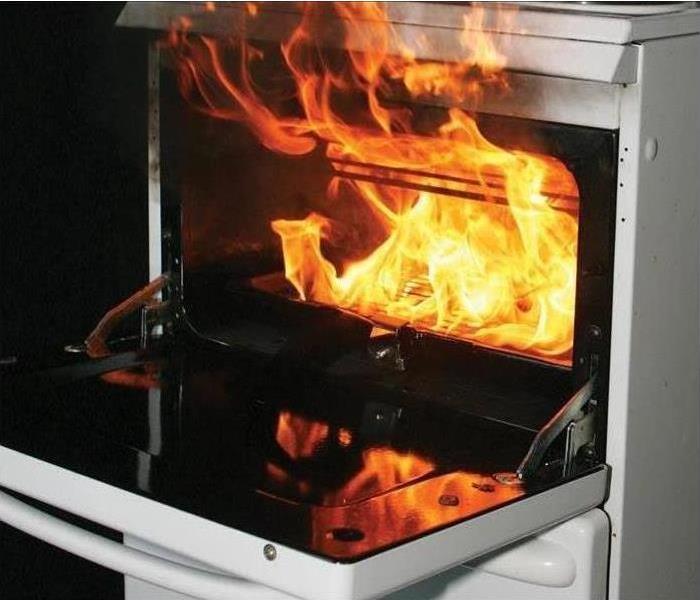 SERVPRO of Lafayette / Moraga / Orinda (925) 299-1323
SERVPRO of Lafayette / Moraga / Orinda (925) 299-1323
The kitchen is the source of many fire hazards because it's where heat, electricity, water and grease come together. The most common type of fire is the grease fire. A grease fire is extremely dangerous as it can get out of control quickly and spread from the stove throughout the kitchen and into other rooms of the house.
Common Causes of Kitchen Fires
- Too high temperature in the fryer
- Vegetable, more flammable, oils
- Old, more flammable oil, in the deep fryer
- Fat deposits in the flue and ventilation ducts
- Misalignment sprinklers due to equipment moved around
- Clogged melting links of the sprinklers leading to impaired function
Other types of kitchen fires include oven fire or the microwave. When a fire starts, keep the door closed and turn off the oven. The lack of oxygen will suffocate the flames. If continues to smoke like a fire use a fire extinguisher or call fire department.
At SERVPRO of Lafayette / Moraga / Orinda we are available 24 hours and 7 days a week. Give us a call at (925) 299-1323. We can help make any fire damage you are facing and make it, "Like it never even happened!"
Pet Fire Safety Tips
5/24/2018 (Permalink)
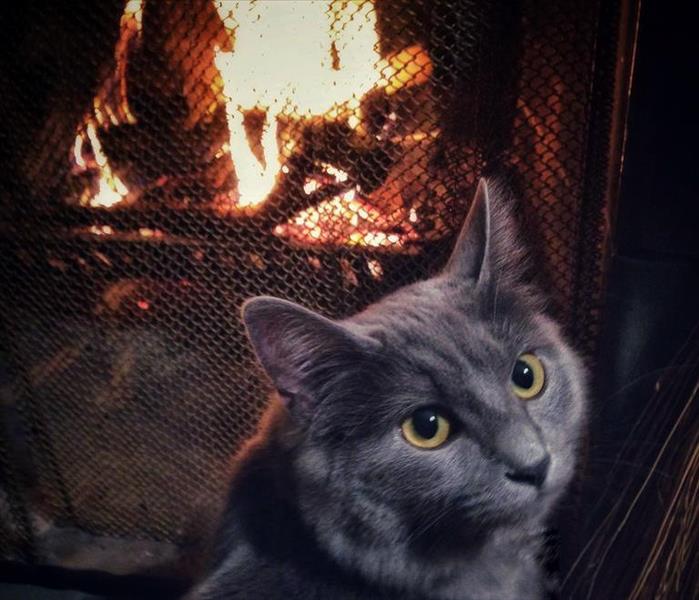 SERVPRO of Lafayette / Moraga / Orinda (925) 299-1323
SERVPRO of Lafayette / Moraga / Orinda (925) 299-1323
- Pets are curious. They may bump into, turn on, or knock over cooking equipment. Keep pets away from stoves and counter tops
- Keep pets away from candles, lamps, and space heaters.
- Always use a metal or heat-tempered glass screen on a fireplace and keep it in place.
- Keep pets away from a chimney’s outside vents. Have a “pet-free zone” of at least 3 feet (1 meter) away from the fireplace. Glass doors and screens can stay dangerously hot for several hours after the fire goes out.
- Consider battery-operated, flameless candles. They can look and smell like real candles.
- Some pets are chewers. Watch pets to make sure they don’t chew through electrical cords. Have any problems checked by a professional.
- Have working smoke alarms on every level of the home. Test your smoke alarms at least once a month.
- If the smoke alarm sounds, get out and stay out.
- Never go back inside for pets in a fire. Tell firefighters if your pet is trapped.
At SERVPRO of Lafayette / Moraga / Orinda we are available 24 hours and 7 days a week. Give us a call at (925) 299-1323. We can help make any fire damage you are facing and make it, "Like it never even happened!"
SERVPRO’s Tips to Prevent Fire Damage in Your Home
12/13/2017 (Permalink)
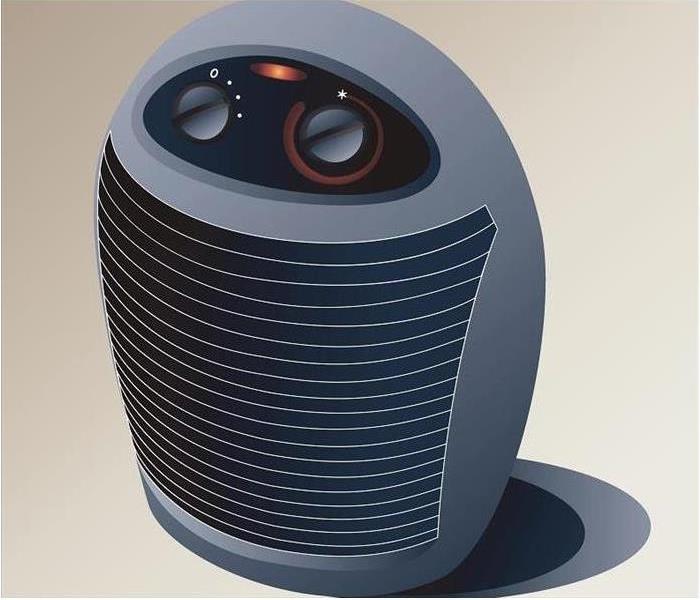 SERVPRO recommends never leaving a portable heater unattended in your home.
SERVPRO recommends never leaving a portable heater unattended in your home.
Space heaters can be a great way to warm up the coldest areas of your house throughout the harshest of winter months. They are not without their potential threats, however. Monitoring them carefully and not leaving these heaters running unattended can help prevent unnecessary damage to your home, let alone those who live inside of it.
Electric and gas space heaters offer a great deal of warmth and can completely transform the coldest areas of your house into the most comfortable. They also put out lots of concentrated heat, and many of them feature grills or open flames that burn hot enough to scald a person or to catch loosely hanging fabrics or drapes on fire. There are some words of caution about these heaters if you want to virtually eliminate the possibility of fire damages to your residence.
The first step is to consider the placement of your heater very wisely. While it might require being close enough to an outlet to plug in, you should be mindful of the furniture and other objects in the room that could inadvertently make contact with the heater. With the excessive heat and open design of many of the small room heaters, something left too close to the heat could catch on fire (even without directly touching).
As many of our experienced SERVPRO team would tell you, preventing fire damage is often as simple as walking yourself through all of the scenarios that might happen. People do not intend to set their homes on fire, but these accidents can happen with a lack of foresight. As an added precaution, you should not leave these types of heaters on unattended in a room that you are not currently occupying.
While regrettable, house fires and small incidents do occur when using space heaters. While it might not be significant enough to force you to leave the house, sometimes the remains of the soot or the lingering odor of burned materials can be more than you can repair or remedy on your own. Our fire restoration team is equipped with deodorizing equipment to neutralize smoke and foul odors, and our commitment to mitigating your loss ensures that we restore the damage promptly.
No matter what degree of fire damage you might have to deal with, you can trust us at SERVPRO of Lafayette/Moraga/Orinda to make it right. Call us 24/7 at (925) 299-1323.
Dangers of Frying A Turkey
12/13/2017 (Permalink)
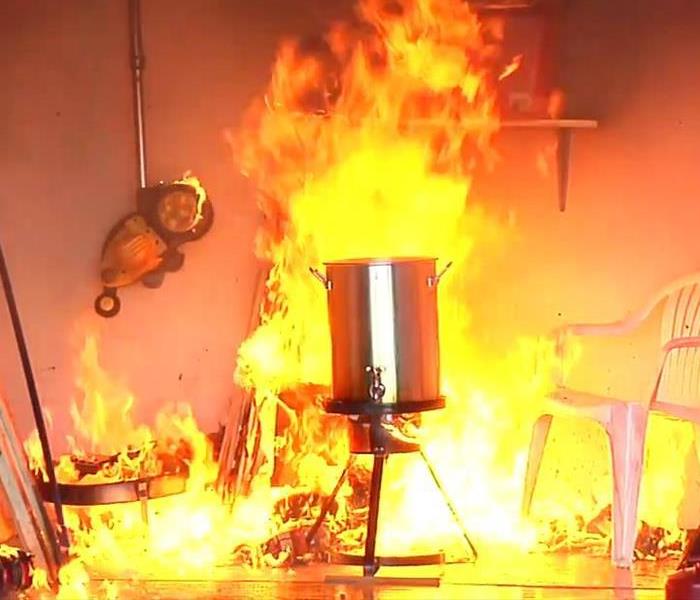 A turkey should never be fried in an enclosed space
A turkey should never be fried in an enclosed space
In recent years deep-frying turkeys has become increasingly popular. The cooking method requires placing the turkey in 3 gallons or more of oil, heated by propane.
The SERVPRO warns that cooking with deep-fat turkey fryers can be very dangerous as they have a high risk of tipping over, overheating, or spilling hot oil and could lead to fires, burns, or other injuries.
5 Dangers of Frying a Turkey
Here are 5 dangers associated with deep frying a turkey, according to SERVPRO:
- A small amount of cooking oil coming into contact with the burner can cause a large fire.
- An overfilled cooking pot or partially frozen turkey will cause cooking oil to spill when the turkey is inserted.
- The sides of the cooking pot, lid and pot handles can get dangerously hot, creating severe burn hazards.
- Units can easily tip over, spilling hot cooking oil over a large area.
- Without thermostat controls, deep fryers have the potential to overheat the oil to the point of combustion.
Turkey Frying Safety Tips
SERVPRO advises against using a turkey fryer. If you decide to do it anyway, these precautions should be followed. Please follow these tips to stay safe:
- Do not overfill the fryer.
- Fryers should always be used outdoors, on a solid level surface a safe distance from buildings and flammable materials.
- If a turkey fryer fire occurs, call 911 immediately.
- Keep all-purpose fire extinguishers nearby.
- Make sure the turkey is completely thawed before it is placed in a fryer.
- Never leave the fryer unattended because, without thermostat controls, the oil will continue to heat until it catches fire.
- Never let children or pets near the fryer when in use or after use as the oil can remain hot for hours.
- Never use a fryer on a wooden deck, under a patio cover, in a garage or enclosed space.
- Use well-insulated potholders or oven mitts and wear long sleeves and safety goggles to protect from splatter.
About SERVPRO of Lafayette/Moraga/Orinda
SERVPRO of Lafayette/Moraga/Orinda specializes in the cleanup and restoration of residential and commercial property after a fire, smoke or water damage event. Our staff is highly trained in property damage restoration. From initial and ongoing training at SERVPRO’s corporate training facility to regular IICRC-industry certification, rest assured our staff is equipped with the knowledge to restore your property. SERVPRO of Lafayette/Moraga/Orinda has the experience and training to make your home safe and livable again. Call us at 925-299-1323 to learn more about our professional cleanup services.
Understanding the Different Types of Smoke Damage
8/21/2017 (Permalink)
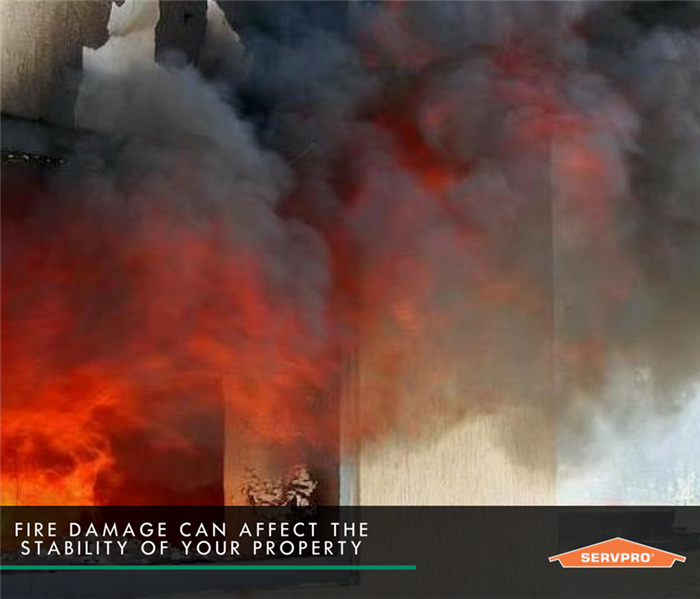 Knowing the different types of smoke and their behavior patterns are vital to proper cleanup and restoration.
Knowing the different types of smoke and their behavior patterns are vital to proper cleanup and restoration.
After the fire truck leaves, your Lafayette home likely suffers from a serious smoke and soot damage. Smoke damage can exist in many forms and each type can have different levels of impact on your property and require different method for restoration. Since smoke and soot is very invasive, they can penetrate into materials causing discoloration and odors, and can leave behind residue buildup. SERVPRO of Lafayette/Moraga/Orinda professionals are thoroughly trained in fire cleanup and restoration. Our technicians know the different types of smoke and their behavior patterns, which is vital to proper restoration.
Smoke and Soot Facts:
- Hot smoke migrates to cooler areas and upper levels of a structure.
- Smoke flows around plumbing systems, seeping through the holes used by pipes to go from floor to floor.
- The type of smoke may greatly affect the restoration process.
Different Types of Smoke
There are two different types of smoke–wet and dry. As a result, there are different types of soot residue after a fire. Before restoration begins, SERVPRO of Lafayette/Moraga/Orinda will test the soot to determine which type of smoke damage occurred. The cleaning procedures will then be based on the information identified during pretesting. Here is some additional information:
- Dry Smoke Residue– Dry smoke residue occurs during fast burning fires that burn at a high temperature. Dry smoke residue is generally dry, powdery, and does not smear much.
- Wet Smoke Residue-Wet smoke residue occurs from smoldering fires with low heat. Dry smoke residue is sticky with strong smoke odors. During cleaning, wet smoke residue can smear, making cleanup more difficult.
- Protein Residue– Protein residue is essentially invisible and it can discolor paints, varnishes, and other finishes. Although this residue is not very visible, it has a very strong smell.
- Fuel / Oil Residue– Fuel oil residue rarely comes from fires unless petroleum products were being stores on site. More commonly fuel and oil residue restoration comes from furnace puff backs that cause a fuel oil soot. This can be relatively sticky and difficult to clean.
- Other Types – Tear gas, fingerprinting powder and fire extinguisher residue.
Since each smoke and fire damage situation is a little different, each one requires a unique solution tailored for the specific conditions. We have the equipment, expertise, and experience to restore your fire and smoke damage. We will also treat your family with empathy and respect and your property with care.
Have Questions about Fire, Smoke, or Soot Damage? Call Us Today – (925) 299-1323.
Wildfire Prevention and Safety Tips
8/15/2017 (Permalink)
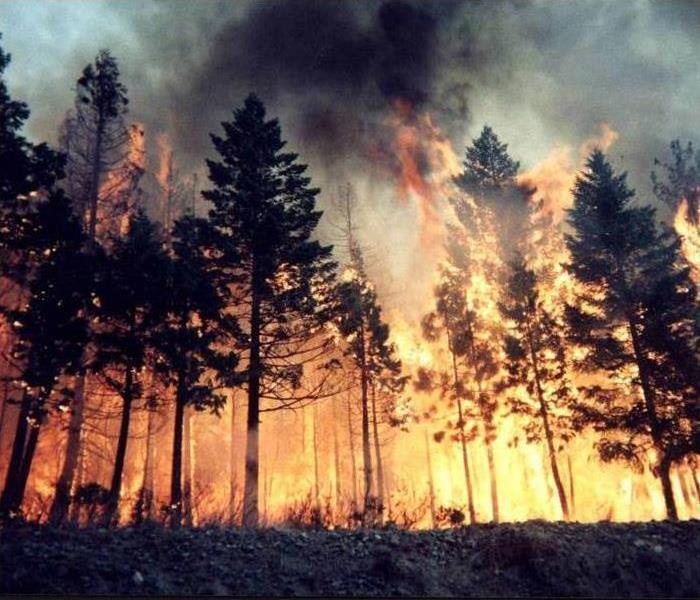 If your home or business is damaged by wildfires, SERVPRO of Lafayette/Moraga/Orinda can help restore your property to preloss condition.
If your home or business is damaged by wildfires, SERVPRO of Lafayette/Moraga/Orinda can help restore your property to preloss condition.
Wildfires can occur at anytime and anywhere throughout the year. Late summer and early fall is typically the peak time for wildfires in California. People that live or work in an area prone to wildfires are at greater risk. Wildfires sometimes start naturally by heat ignited from sun light or lightning strikes. However, majority of the wildfires in the U.S. are caused by humans. Some human-caused fires result from campfires left unattended, negligently discarded cigarettes or intentional acts of arson. A wildfire can move as fast as 6.5 miles per hour in forest and 14 miles an hour in grassland, consuming trees, homes, natural resources, humans and everything in its path.
By working together, we can make our residents and neighborhood safer from wildfires by taking safety precautions. Here are some wildfire safety tips to help prevent wildfire from occurring.
Wildfire Safety Tips
- Clear leaves and other debris from gutters, eaves, porches and decks. Remove dead vegetation from under your deck and within 10 feet of the house. This prevents embers from igniting your home.
- Remove anything stored underneath decks or porches. Screen or box-in areas below patios and decks with wire mesh to prevent debris from accumulating.
- Ensure flammable materials (firewood stacks, propane tanks, dry vegetation) are more than 30 feet from your home or business's foundation and outbuildings.
- Wildfire can spread to tree tops. If you have trees on your property, prune so the lowest branches are 6 to 10 feet from the ground.
- Keep your lawn hydrated and maintained. If it is brown, cut it down to reduce fire intensity. Dry grass and shrubs are fuel for wildfire.
- Inspect shingles or roof tiles. Replace or repair shingles that are loose or missing to prevent ember penetration.
- Cover exterior attic vents with metal wire mesh no larger than 1/8 inch to prevent sparks from entering the home.
- Enclose eaves and screen soffit vents using 1/8 mesh metal screening to prevent ember entry.
SERVPRO of Lafayette/Moraga/Orinda specializes in fire and water damage restoration. We have the specific damage restoration training, personnel, and equipment and can quickly restore your home to pre-fire condition. Call us today 925-299-1323.
Grilling Safety Tips
5/26/2017 (Permalink)
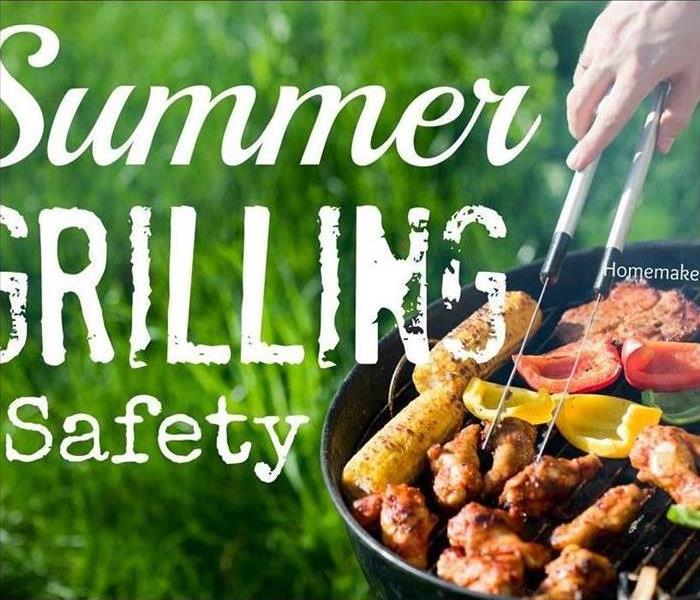 Follow these simple grilling safety tips to keep your family and friend safe during the cookout season.
Follow these simple grilling safety tips to keep your family and friend safe during the cookout season.
When the weather gets warmer, there’s nothing better than the smell of food on the grill. Grilling and cookouts are the most popular activities outdoor. It’s a great way to relax and have fun with family and friends. Weather the barbecuing takes place at the beach, picnic area, camping site or just out in the backyard, grilling can poses risk of fire if not handled properly. According to a (NFPA) National Fire Protection Association report, nearly 9,000 homes fires are caused by grilling in the US and close to half of all injuries involving grills are due to thermal burns.
Causes of Grill Fires:
The leading causes of grill fires were a failure to clean, having the grill too close to something that could catch fire and leaving the grill unattended.
A leak or break was the leading cause for outside or unclassified grill fires. Leaks or break were primarily a problem with gas grills.
General Grilling Tips:
- Propane and charcoal BBQ grills should only be used outdoors.
- The grill should be placed well away from the home, deck railings and out from under eaves and overhanging branches.
- Keep children and pets away from the grill area.
- Keep your grill clean by removing grease or fat buildup from the grills and in trays below the grill.
- Never leave your grill unattended.
If you encounter fire damage during this cookout season, give SERVPRO of Lafayette/Moraga/Orinda a call. We're dedicated to being faster to any size disaster, has the training, equipment and expertise to handle your restoration and cleaning needs. We’re close by and ready to respond immediately when you need us. We make disaster "Like it never even happened." Give us a call today at (925) 299-1323
Fire Safety Tips When Cooking
5/26/2017 (Permalink)
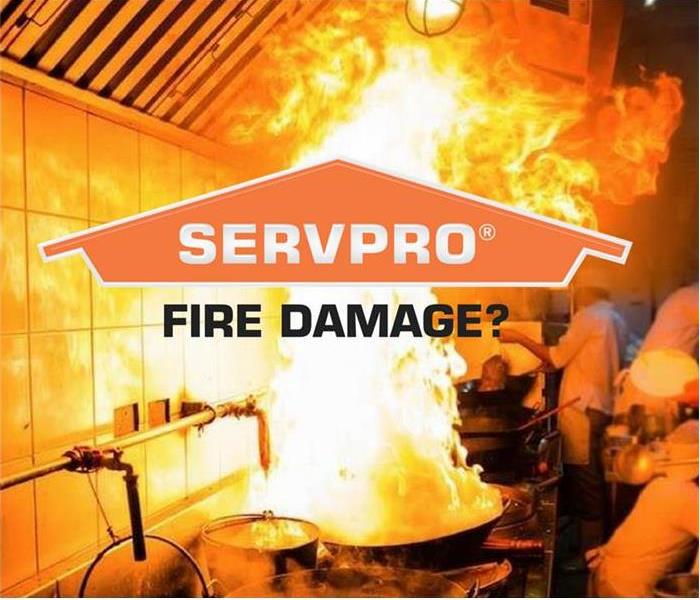 Follow these fire safety tips, be alert and watch what you are cooking at all times.
Follow these fire safety tips, be alert and watch what you are cooking at all times.
As we look forward to the upcoming holiday season of Memorial Day, Independence Day and Labor day (to name a few) many of us will invite our family and friends to celebrate these major holidays. These can be exciting especially preparing some delicious dishes for the party. Whether you’re cooking indoor or outdoor, there is always a potential for fire hazard in the kitchen or in the backyard. Did you know that U.S. fire departments responded to an average of 166,100 home structure fires that involved cooking equipment per year? The leading cause of fires in the kitchen is unattended cooking. So before you turn on your stove, here are some fire safety tips prevention.
Here's What You Need to Know:
• Be on alert! If you are sleepy or have consumed alcohol don’t use the stove or stove top.
• Stay in the kitchen while you are frying, grilling, boiling or broiling food.
• If you are simmering, baking or roasting food, check it regularly, remain in the kitchen while food is cooking, and use a timer to remind you that you are cooking.
• Keep anything that can catch fire—oven mitts, wooden utensils, food packaging, towels or curtains—away from the stovetop.
What to Do During a Fire:
• Just get out! When you leave, close the door behind you to help contain the fire.
• Call 9-1-1 or the local emergency number after you leave.
• For an oven fire turn off the heat and keep the door closed.
• If you try to fight the fire, be sure others are getting out and you have a clear way out.
• Keep a lid nearby when you’re cooking to smother small grease fires. Smother the fire by sliding the lid over the pan and turn off the stovetop. Leave the pan covered until it is completely cooled.
If you have the unfortunate experience of fire or smoke damage in your home or business call SERVPRO of Lafayette/Moraga/Orinda!
We are available 24 hours a day and are always Here to Help! Have Questions? Call Us Today – (925) 299-1323
Safety Tips in Case of a Fire at Home
11/1/2016 (Permalink)
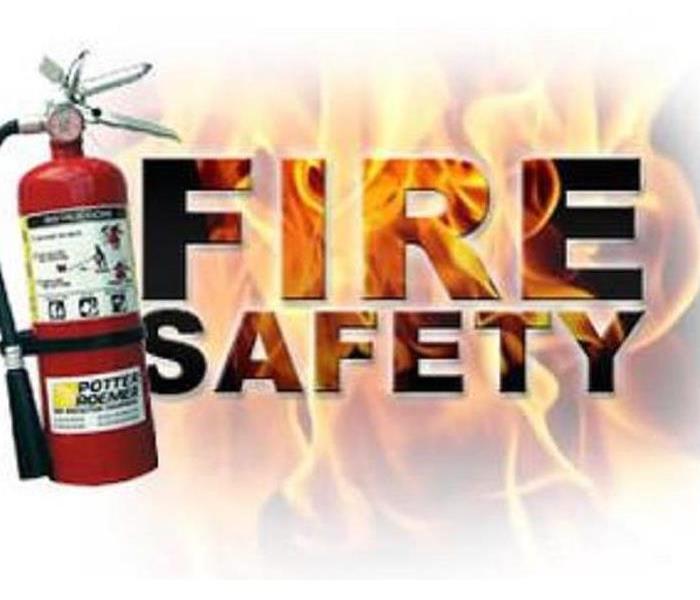 Important fire safety tips to help you and your family in case of a fire at home.
Important fire safety tips to help you and your family in case of a fire at home.
Important and useful safety tips in case of a fire at home
In case of a fire at your home, your priority is to get yourself and your family members out as quickly as possible. There is no time to gather valuables. Fire can spread out within seconds and in just a few minutes, it can become life-threatening.
Don't attempt to extinguish any fire if there is a threat to your safety. If you're unable to exit your home safely because of smoke or fire, remain in your room until it is safe to do so. Keep door closed and await assistance from the fire department.
After the fire trucks leave, your home likely suffers from fire, smoke damage and extensive water damage from firefighting efforts. At SERVPRO of Lafayette/Moraga/Orinda, we have the specific damage restoration training, personnel, and equipment and can quickly restore your home to pre-fire condition.
Have Questions about Fire, Smoke, or Soot Damage?
Give us a call at (925) 299-1323.
What to Do and Don't Do After a Fire
11/1/2016 (Permalink)
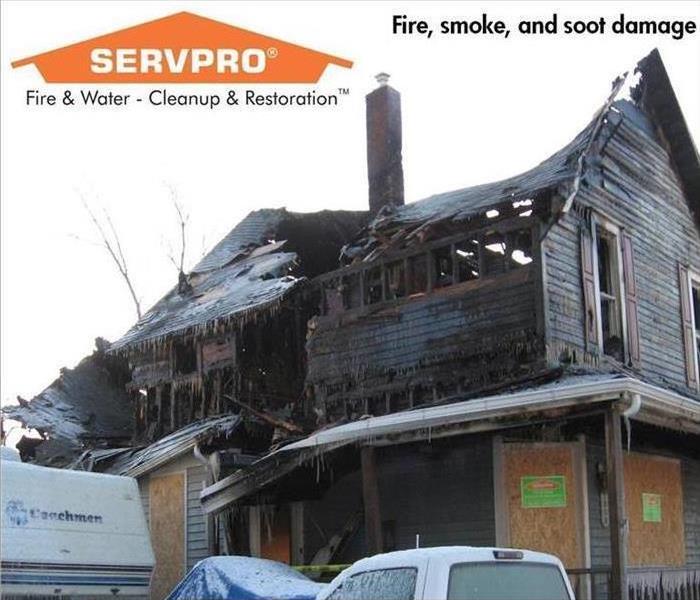 SERVPRO of Petaluma/Rohnert Park have specialized fire and smoke damage restoration training and experience to quickly clean up and restore your home.
SERVPRO of Petaluma/Rohnert Park have specialized fire and smoke damage restoration training and experience to quickly clean up and restore your home.
What You Can Do Until Help Arrives
The most important thing is to understand the risk to your safety and health even after the fire is out. The soot and dirty water left behind may contain things that could make you sick.
Here's What to Do and Don't Do After a Fire.
DO:
- Limit movement in the home to prevent soot particles from being embedded into upholstery and carpets.
- Keep hands clean so as not to further soil upholstery, walls and woodwork.
- Place clean towels or old linens on rugs, upholstery and carpet traffic areas.
- If electricity is off, empty freezer and refrigerator and prop doors open.
- Clean and protect chrome with light coating of petroleum jelly or oil.
- Wash houseplants on both sides of leaves.
- Change HVAC filter.
- Tape double layers of cheesecloth over air registers
DON'T:
- Attempt to wash any walls or painted surfaces without first contacting your SERVPRO Franchise Professionals.
- Attempt to shampoo carpet or upholstered furniture without first consulting your SERVPRO Franchise Professionals.
- Attempt to clean any electrical appliances (TV, sets, radios, etc.) that may have been close to fire, heat or water without first consulting an authorized repair services.
- Consume any food or beverages that may have been stored close to fire, heat or water. They may be contaminated.
- Turn on ceiling fixtures if ceiling is wet. The wiring may be wet or damaged and can cause electrical shock.
- Send garments to the dry cleaner. Improper cleaning may set in smoke odor.
If your home or business has been damaged by the fire, you may not know where to turn. SERVPRO of Lafayette/Moraga/Orinda is here to help restore your property to preloss condition and make it, "Like it never even happened!" We are available 24 hours a day and can have a team of technicians out to your property in no time!
Have Questions? Call Us Today – (925) 299-1323
Common Causes of Kitchen Fires
11/1/2016 (Permalink)
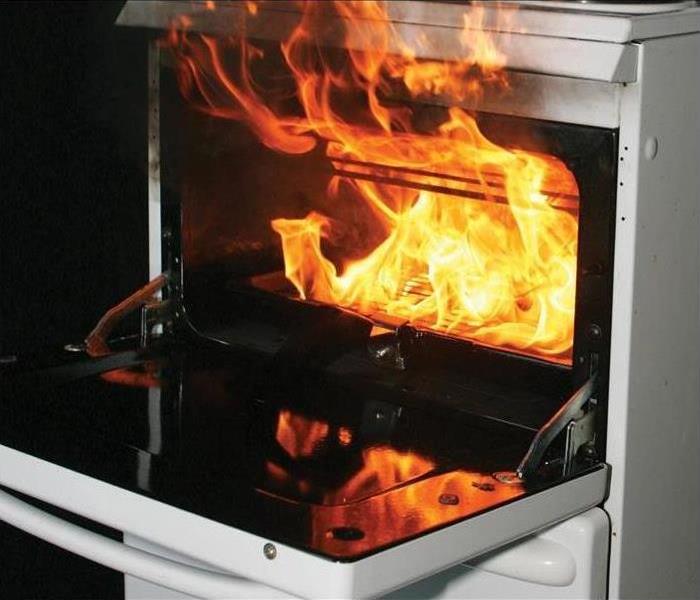 When a fire starts inside your oven, keep the door closed and turn it off immediately. The lack of oxygen will suffocate the flames.
When a fire starts inside your oven, keep the door closed and turn it off immediately. The lack of oxygen will suffocate the flames.
The kitchen is the source of many fire hazards because it's where heat, electricity, water and grease come together. The most common type of fire is the grease fire. A grease fire is extremely dangerous as it can get out of control quickly and spread from the stove throughout the kitchen and into other rooms of the house.
Common Causes of Kitchen Fires
- Too high temperature in the fryer
- Vegetable, more flammable, oils
- Old, more flammable oil, in the deep fryer
- Fat deposits in the flue and ventilation ducts
- Misalignment sprinklers due to equipment moved around
- Clogged melting links of the sprinklers leading to impaired function
Other types of kitchen fires include oven fire or the microwave. When a fire starts, keep the door closed and turn off the oven. The lack of oxygen will suffocate the flames. If continues to smoke like a fire use a fire extinguisher or call fire department.
At SERVPRO of Lafayette/Moraga/Orinda we are available 24 hours and 7 days a week. Give us a call at (925) 299-1323. We can help make any fire damage you are facing,"Like it never even happened!"
Winter Fire Safety Tips
11/1/2016 (Permalink)
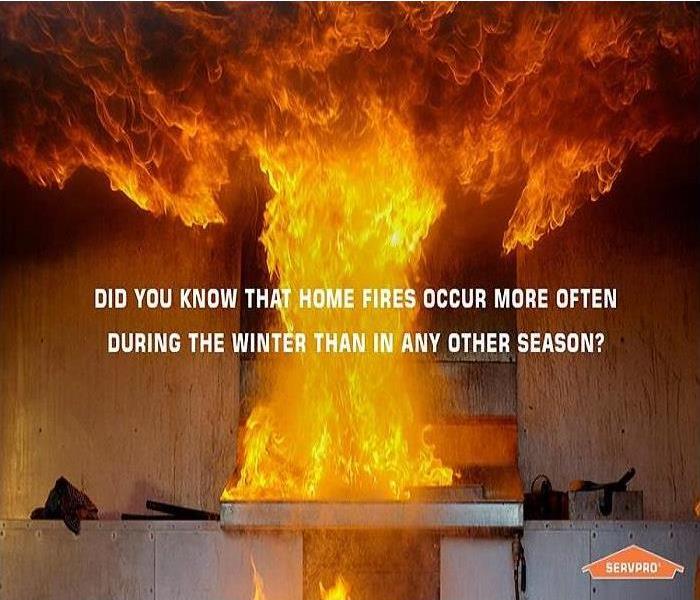 Practicing the best fire safety is how you can be most prepared for unexpected disaster in the winter.
Practicing the best fire safety is how you can be most prepared for unexpected disaster in the winter.
The winter season is just around the corner which means that home fires occur more often by unattended candles, space heaters, wood stoves and fireplaces.
At SERVPRO of Lafayette/Moraga/Orinda, we want to remind everyone to take simple steps to protect their homes and family from the danger of household hazards and heating equipment. Practicing the best fire safety is how you can be most prepared for unexpected disaster in the winter.
Here are some fire safety tips to prevent most heating related fires from happening:
- Keep anything that can burn at least three feet away from heating equipment, like the furnace, fireplace, wood stove, or portable space heater.
- Have your chimneys and vents checked. If you light fires frequently, you need a chimney sweep service once a year.
- Make sure the fireplace has a sturdy screen to stop sparks from flying into the room.
- Test smoke alarms. Make sure batteries are fresh. Place smoke alarms in the kitchen, laundry room and in bedrooms.
- Beware of lit candles. Candles can set the mood for relaxation, and that's how they get forgotten or knocked over by kids or pets.
- Beware of space heaters. Like fireplaces, people and pets should not be allowed to sit any closer than three feet.
- Don't put space heaters near curtains, tablecloths or other fluttering fabrics.
- Make sure the space heaters you buy have automatic shut-offs before reaching dangerous temperatures.
If you have the unfortunate experience of fire or smoke damage in your home or business call SERVPRO of Lafayette/Moraga/Orinda!
We are available 24 hours a day and are always Here to Help! Have Questions? Call Us Today – (925) 299-1323
Any time disaster strikes, so do we
7/7/2016 (Permalink)
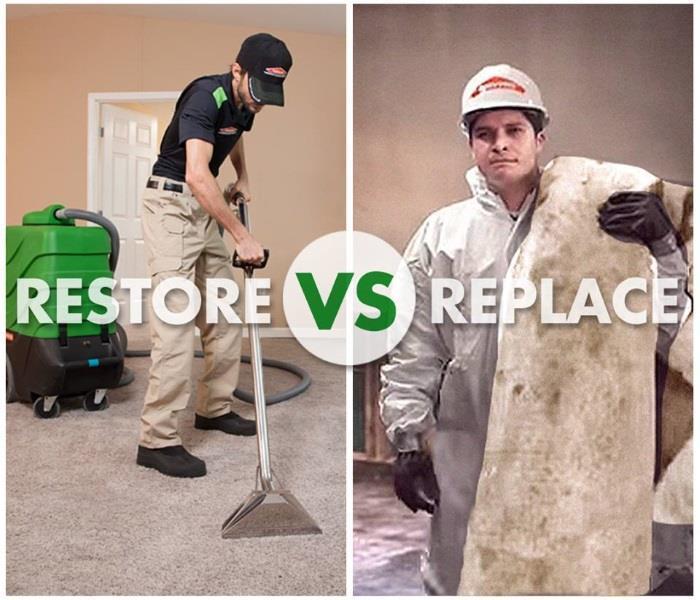 Servpro of Lafayette/Moraga/Orinda
(925) 299-1323
Servpro of Lafayette/Moraga/Orinda
(925) 299-1323
At SERVPRO of Lafayette/Moraga/Orinda we know the first 48 hours after a fire can make the difference between restoring versus replacing your property. We are a 24-Hour Emergency Service, are Faster to Any-Sized Disaster, are a team of highly trained restoration technicians, are Locally Owned and Operated, and are a trusted leader in the Restoration Industry.
It is important to know who to call when an emergency happens because you never know when disaster will strike! One of the most common causes of fires is cooking equipment, followed by heating equipment, being aware and prepared for emergency situations can be the difference in saving and salvaging your property. Make sure to have smoke alarms up in each room and check them regularly to ensure they’re properly working.
We are a 24-Hour Emergency Service that can respond immediately to your emergency with the expertise to handle your restoration or cleaning needs! At SERVPRO of Lafayette/Moraga/Orinda we want to make your damages “Like it never even happened” and get your home or business up and running again as soon as possible.
If you have experienced fire damages give us a call at (925) 299-1323 at any time during the day or night! The great thing about being 24/7 emergency service, we are ALWAYS “Here to Help”
Summer Heat
6/15/2016 (Permalink)
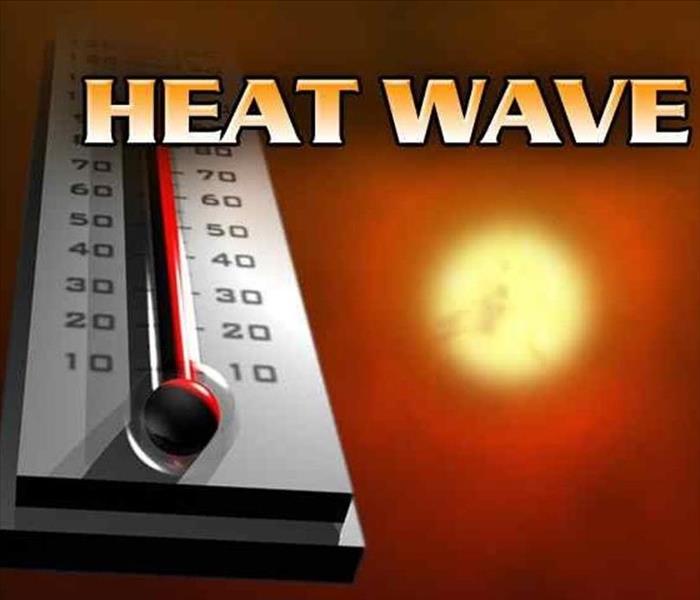 Servpro of Lafayette/Moraga/Orinda
925-299-1323
Servpro of Lafayette/Moraga/Orinda
925-299-1323
At SERVPRO of lafayette/Moraga/Orinda we're here to help you get ready for the Summer heat.
Summer Tips!
Emergency Kit
Make a family Communication.
weather stips doors.
To reduce 80 percent of the heat that enters your home. Cover windows that receive morning and afternoon sun.
Stay aware of upcoming temperature changes. Listen to local weather forecasts.
Window air conditioners snugly; insulate if necessary.
Get the trained in first aid to learn how to treat heat-related emergencies.
Stay safe this summer!
Safe Grillin'
6/3/2016 (Permalink)
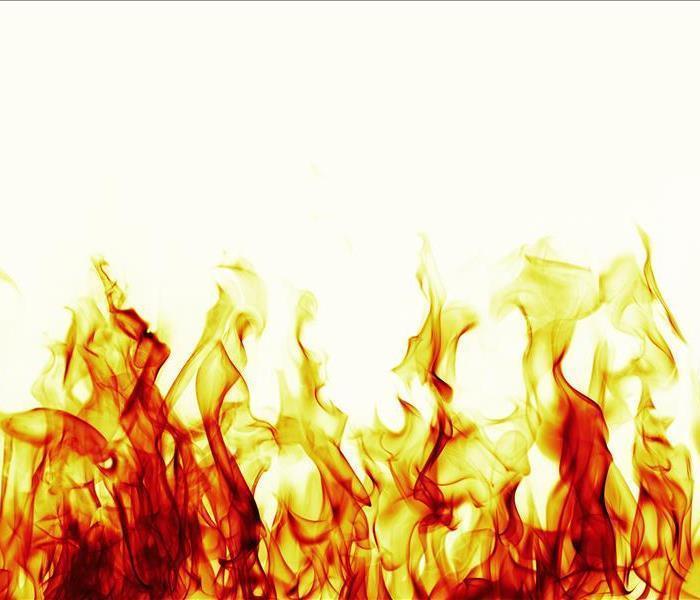 Servpro of Lafayette/Moraga/Orinda
925-299-1323
Servpro of Lafayette/Moraga/Orinda
925-299-1323
At SERVPRO of lafayette/Moraga/Orinda we can handle any size Fire, Smoke, Water damage you may incounter, but that doesnt mean we want you to have to call us for sudden fire or smoke damage!
Summer means fun under the sun and for us here in Northern California, you might beat the Beach, at the River, or at home with your grill. Your local SERVPRO wants to remind you to be safe with your grills!
With the heat of summer just begining we at SERVPRO of Lafayette/Moraga/Orinda are thinking about you firing up your grill and want to remind you not to accidentally fire up your home!
Be safe and remember SERVPRO of Lafayette/Moraga/Orinda is always Here to Help if you need it!
You can contact our 24/7 line at 925-299-1323!
Experiencing smoke or fire damages? Call us!
4/1/2016 (Permalink)
If you have the unfortunate experience of fire or smoke damage in your home or business call SERVPRO of Lafayette/Moraga/Orinda with any questions or concerns! We are available 24hours a day and can have a team of technicians out to your property in no time!
Winter happens to be the most common time of the year for fires in a residence, and having smoke from a fire can be just as damaging as a pot left on a hot stove. Make sure you are taking preventative measure in your home or business!
If you have fire or smoke damages to your property give SERVPRO of Lafayette/Moraga/Orinda a call and we can answer any questions you have. We are specialists on Fire, Water, Smoke, and Mold damages, you can rely on us to help restore your property.
Call SERVPRO of Lafayette/Moraga/Orinda today! 925-299-1323
Heater safety, avoid fire damage!
2/16/2016 (Permalink)
 SERVPRO of Lafayette/Moraga/Orinda 925-299-1323
SERVPRO of Lafayette/Moraga/Orinda 925-299-1323
At SERVPRO of Lafayette/Moraga/Orinda we know space heaters are loved for the warmth they provide, but they can also pose a danger to your home if not used properly. By keeping space around your heater clear and away from any flamables you can avoid dealing with fire and smoke damages.
Make sure your keeping your home and families safe during this winter by Make sure you take time to notice signs of outdated wiring, Electrical problems can be a big factor in home fires.
And rememebre SERVPRO of Lafayette/Moraga/Orinda is Always here to help!
If you have any questions or concerns give us a call! We are always available 24 hour a day!
SERVPRO of Lafayette/Moraga/Orinda 925-299-1323
SERVPRO can handle your Fire Damages
1/13/2016 (Permalink)
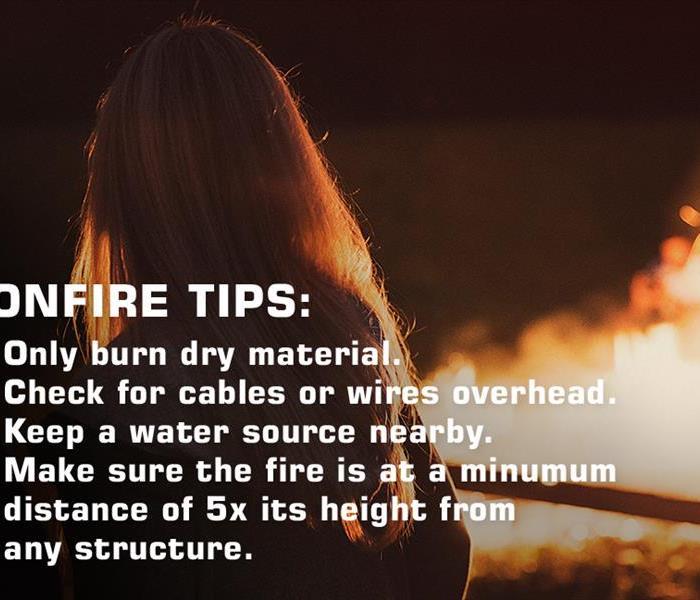 Servpro of Lafayette/Moraga/Orinda is always here to help!
Servpro of Lafayette/Moraga/Orinda is always here to help!
SERVPRO of Lafayette/Moraga/Orinda franchise professionals can take care of your fire damage. By providing timely response with our services, ranging from FIRE, SMOKE, and SOOT removal, to contents claims inventory, and document restoration, and so much more. At SERVPRO of Lafayette/Moraga/Orinda we know the first 48 hours after a fire can make the difference between restoring versus replacing your property. We are always faster to any size disaster and will strive to make your damages "Like it never even happened" always.
We are available 24-hours a day, 365 days a year!
If you have Fire Damage, or any questions call 925-299-1323 now!
Have fire damages? SERVPRO can help!
11/24/2015 (Permalink)
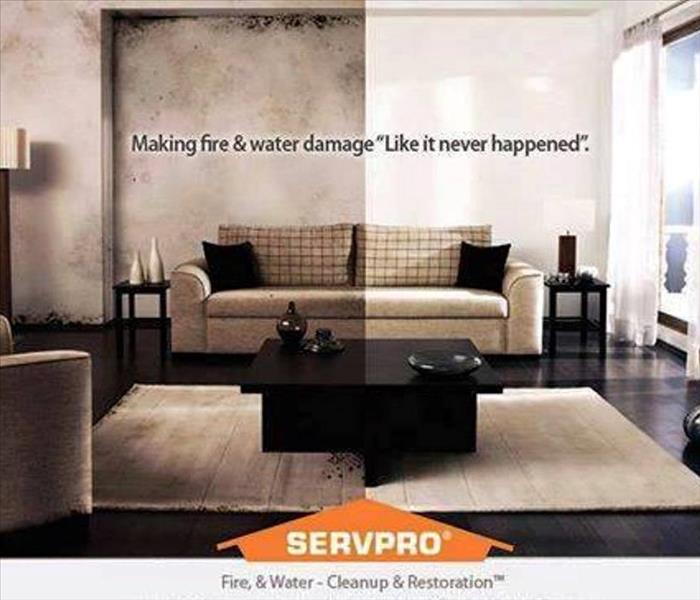 We make your damages "Like it never even happened"
We make your damages "Like it never even happened"
At SERVPRO of Lafayette/Moraga/Orinda provides 24-hour emergency service and is dedicated to being faster to any-sized disaster in Lafayette/Moraga/Orinda and surrounding cities! We can respond immediately to your emergency and have the expertise to handle your restoration or cleaning needs. We are:
- 24-Hour Emergency Service
- Faster to Any-Sized Disaster
- Highly Trained Restoration Technicians
- A Trusted Leader in the Restoration Industry
- Locally Owned and Operated
- Advanced Restoration and Cleaning Equipment
Have Questions? Call Us Today – (925) 299-1323
Residential Services
Whether your Lafayette/Moraga/Orinda home needs emergency Fire Damage, Flood Damage or your upholstery cleaned, you can depend on us. Our technicians have extensive cleaning and restoration training and can make your property look its best. Learn more about our residential services:
- Water Damage Restoration
- Fire Damage Restoration
- Mold Remediation
- Storm Damage Restoration
- Cleaning Services
- Building/Reconstruction Services
Commercial Services
There's never a convenient time for fire or Water damage to strike your Lafayette/Moraga/Orinda commercial property. Every hour spent cleaning up is an hour of lost revenue and productivity. So when the need arises for fast professional cleaning or emergency restoration services we has the training and expertise to respond promptly with highly trained technicians to get your property back to business. Learn more about our commercial services:
- Commercial Water Damage Restoration
- Commercial Fire Damage Restoration
California Fires and Fire Damages
8/3/2015 (Permalink)
The largest fire in California is the Rocky Fire which has consumed 60,000 acres and over a dozen homes. Losing a home and personal effects can be demoralizing and troublesome. Personal belongings are treasures of life and a reflection of hard work and achievements. Photographs, books, and other personal items have value that cannot be put into words. SERVPRO franchise professionals have the ability to help restore your belongings. We understand the importance of your belongings and try to help bring them back to you. We are always here to help.
http://www.pressdemocrat.com/news/4292763-181/containment-of-roaring-rocky-fire#.Vb-gyR1dvik.facebook?page=0






 24/7 Emergency Service
24/7 Emergency Service

